You are using an out of date browser. It may not display this or other websites correctly.
You should upgrade or use an alternative browser.
You should upgrade or use an alternative browser.
The Classic Motorcycle
- Thread starter DaveM
- Start date
- Local time
- Today, 09:50
- Joined
- Jan 5, 2006
- Messages
- 54,198
- Points
- 1,327
- First Name
- Dave
- My Ride
- Speedmaster
- Riding Since
- 1974

Wal Handley (pictured right) with Stanley Woods at 1926 Senior TT
In his heyday, as far as the Press and public were concerned, Wal Handley was the greatest motorcycle racer of all time.
Wal was born in 1903 to a working-class family in Birmingham. His father died suddenly in 1912, leaving Walter, his mother and two other children. At just 12 years of age, Wal worked in a wartime engineering factory. It was hard work with long hours, and not a lot of fun. The experience, however, helped him secure a job in 1921 at Humphries & Dawes, motorcycle manufacturers. It didn’t take long for Wal to be made junior tester.
Having made a good impression, in 1922 he was nominated for the Lightweight TT alongside Nev Hall and Charlie North, the trio riding OK’s Blackburne-engined racers. Whilst Wal raised the lap record by nearly 5mph to a sensational 51mph from a standing start, his race ended early because of a broken exhaust, allowing Geoff Davidson to take the victory.
Davidson beat Wal twice that season, in Belgium and France, but the youngster was the season’s sensation. “Watch that boy,” said ‘Ixion’. Wal’s potential had been spotted, but nobody could have anticipated his future record-breaking spree.

Wal Handley with his BSA.
At the 1923 Lightweight TT, Wal led for four laps before taking a tumble. After a lengthy pit stop and calls for him to sit out, he re-started and managed to finish eighth. Again, the story wasn’t so much about the finishing position as his record-breaking racing. On each of his first three laps, Wal had broken the fastest speed record, reaching 53.95mph.
In the same year Wal left OK to join Rex Acme, and immediately enjoyed success. At the 1923 Ulster Grand Prix, he was the overall winner on a 250cc Blackburne on handicap from Jimmie Shaw on his 350cc Zenith, and Joe Craig on a 500cc Norton.
The 1924 season proved to be a largely depressing one for Wal. He led, but retired in the 175cc, 250cc and 350cc races in the Island TT, with no fastest laps to save his blushes.
The following year saw his luck turn, winning the Junior TT at 10mph faster than the previous year’s winner, and taking first place in the Ultra Lightweight 175cc. Wal retired in the 250cc with a puncture, but he was pleased with his season, with two wins from three races, alongside three record fastest laps.
Gifted but mechanically unlucky

The racing Rudges – In torrential rain, Wal Handley crosses the finishing line to claim a record-breaking TT win.
At the 1926 TT, Wal finished in third position on a 350cc Rex Acme Blackburne. He led the first lap, but had to stop – not once, but twice – to change a choked main jet. As if he hadn’t been unlucky enough, his brake shoe return spring broke on the third lap and jammed on the front brake. Then his bike’s gear change quadrant came adrift. Finishing third looked a remarkable achievement.
In the Senior TT, Wal managed to finish second. From the get-go he, Stanley Woods and Jimmy Simpson broke away from the rest of the pack. Disaster struck when, on the second lap, the rear plug on his Blackburne V-twin cut out. It took seven minutes for his team to fix the bike and return to action, re-joining in 22nd place. Wal still managed to finish second.
The race was already on its eighth lap – enough for any racer to sit out. Not for Wal Handley.
At the 1926 Brooklands race meeting, at the start line Wal’s engineer Sammy Jones noticed a three-inch deep cut to the front tyre. It was never discovered whether it was an accident or sabotage. It certainly wasn’t the first time it had happened in motorcycle racing, however, and definitely wasn’t to be the last.
Wal returned to the paddock, where his team removed the wheel and changed the cover, taking a quarter-of-an-hour for the bike to return to the track. The race was already on its eighth lap – enough for any racer to sit out. Not for Wal.
Bill Lacey won on his Grindley Peerless J.A.P. at an average speed of 81.20mph. Wal Handley, joining 15 minutes and eight laps later, somehow finished second at an average speed of 88mph – breaking seven world records, including riding at over 91mph at 350cc and 500cc. It proved to be the story of the 1937 Brooklands that Wal Handley would be most notable for.
Record-breaking 1937 Brooklands

Wal Handley made headlines in The Motor Cycle in the summer of 1937. Photo: Mortons Archive.
The BSA Empire Star was a machine that had more far-reaching results than even its makers could have reasonably expected. The company from Small Heath, Birmingham, was always known for no-nonsense, value-for-money motorcycles, and that was undoubtedly designer Val Page’s aim when he revised the BSA singles range in 1937.
It was the 500cc Empire Star that appeared at the Brooklands race meeting in June 1937. Whilst it looked fairly standard, it had been carefully prepared by BSA staff, including Page himself, Hubert Perkins and cam expert Jack Arnott.
A racing magneto was naturally used, and with its compression ratio boosted to 13:1 to take advantage of alcohol fuel, the Empire Star produced about 33bhp – approaching double the standard output.

BSA Gold Star named after Wal Handley’s performance at Brooklands. Photo: Mortons Archive.
A top jockey was needed, and Bert Perrigo – himself a successful competition rider in vintage years – persuaded Wal Handley to come out of retirement for the day. To use a cliché, the rest is history.
Setting off at the back of the handicap field, on the first of three laps Wal found himself weaving past lesser bikes, but once clear he achieved a race average of over 102mph, with a fastest lap of an astonishing 107.57mph!
A Brooklands Gold Star was awarded in recognition of Handley’s feat, and BSA immediately appropriated the name for its fastest machines. The prestigious BSA Gold Star was applied to a whole succession of sporting motorcycles and remained in use until 1963.
For Wal, he earned nine TT podiums over his career with four wins, as he ventured to car racing for a couple of years before becoming a pilot in the Second World War effort.
Captain Walter L. Handley was killed flying a RAF Airacobra I on November 15, 1941 while serving with the Air Transport Auxiliary. The plane crashed shortly after taking off from RAF Kirkbride.
A memorial is being held near to where he died, in tribute and to mark 77 years since one of Britain’s greatest motorcycle racers of all time, Wal Handley’s death.
- Local time
- Today, 09:50
- Joined
- Jan 5, 2006
- Messages
- 54,198
- Points
- 1,327
- First Name
- Dave
- My Ride
- Speedmaster
- Riding Since
- 1974
Good Kop
The Kop Hill Climb has become an established event on the calendar, its low-key charm attracting record attendances.
Words and photographs: James Adam Bolton
By now a well-established event in the vintage and classic car and motorcycle calendar, 2019 was the 10th anniversary year of the rejuvenated event, an event first run in 1910.
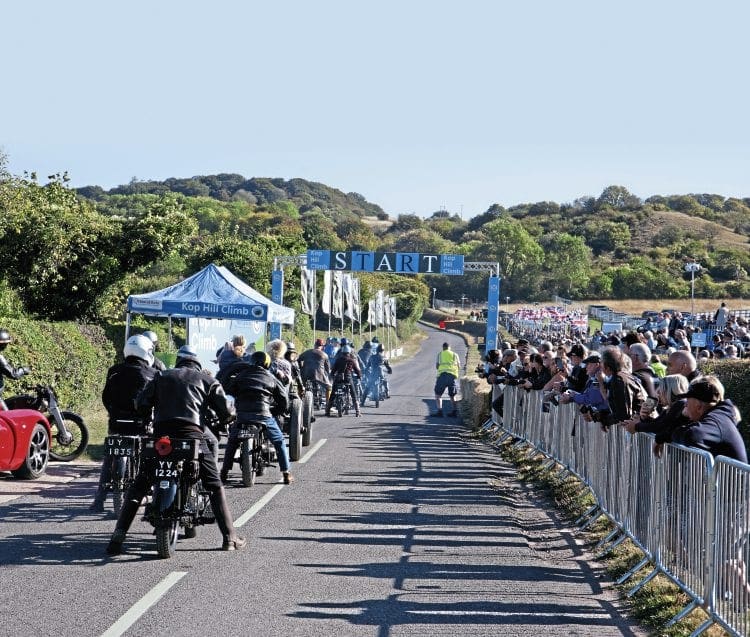
The now revived and revered Kop Hill Climb has taken place over a long, and usually sunny weekend in September, raising much needed funds for charities local to Kop Hill’s beautiful Chilterns location near Princes Risborough, Buckinghamshire.
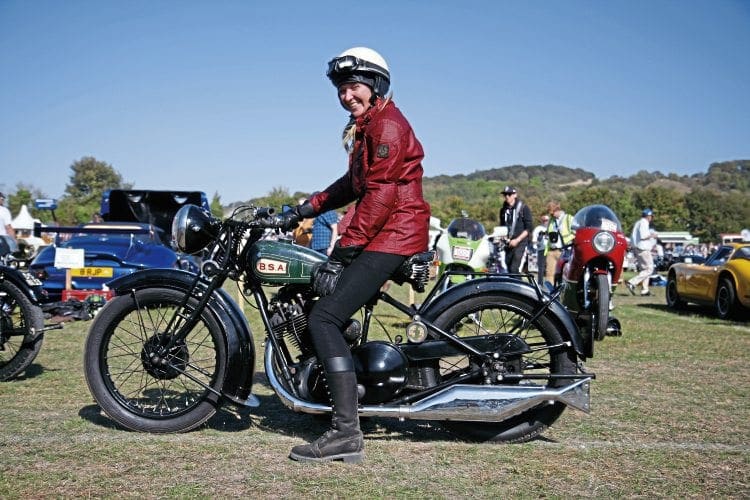
Joanne Staton is a Kop Hill regular, and this year took both her 500cc 1929 BSA Sloper S30-13, and 1991 Kawasaki KR1-S up the hill. Diversity guaranteed at Kop Hill!
Though there were some showers on the Sunday, the crowds came out over the weekend, and Saturday’s blazing hot day drew the largest day attendance ever.
The selection of motorcycles going up the hill (strictly in a non-competitive manner!) and on display was particularly eclectic this year, ranging from fine early vintage machines such as the 1919 Dart-JAP V-twin, to a rare and very smart 1979 Honda CB750 Phil Read Replica, with everything and anything in between.
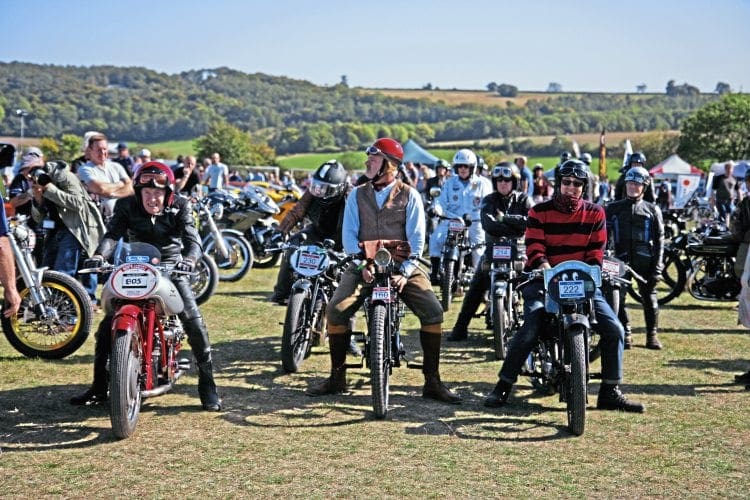
Entrants in the vintage motorcycles section prepare to go up the hill, with Sammy Miller leading the pack.
Special guest for the first time was Sammy Miller MBE, who brought along his 1950 Moto Guzzi 500cc Bicilindrica and 1957 ohc Gilera 500cc four racers, both of which he thrashed up the hill with aplomb, to the thrill and possible temporary hearing detriment of the crowds in the grandstands.
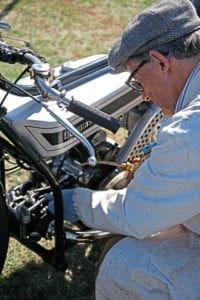
A white coat, flat cap and much concentration are de rigueur for last-minute oiling of this 1928 Douglas SW5 Speed Model, belonging to Terry Wilson, another Kop Hill regular.
It was good to see some interesting, more ‘modern’ and beautifully crafted specials along with the usual choice of fabulous Broughs, Vincents, Triumphs, Rudges, you name it.
Many tens of thousands of pounds are raised at this petrolhead’s paradise of a weekend every year, so if you love old motorcycles, cars and helping out charities at the same time, get along there next year.
■ Kop Hill next year – September 19/20, 2020
■ www.kophillclimb.org.uk
View more images of the Kop Hill Climb and read more News and Features in the December 2019 issue of The Classic Motorcycle –on sale now!
The Kop Hill Climb has become an established event on the calendar, its low-key charm attracting record attendances.
Words and photographs: James Adam Bolton
By now a well-established event in the vintage and classic car and motorcycle calendar, 2019 was the 10th anniversary year of the rejuvenated event, an event first run in 1910.

The now revived and revered Kop Hill Climb has taken place over a long, and usually sunny weekend in September, raising much needed funds for charities local to Kop Hill’s beautiful Chilterns location near Princes Risborough, Buckinghamshire.

Joanne Staton is a Kop Hill regular, and this year took both her 500cc 1929 BSA Sloper S30-13, and 1991 Kawasaki KR1-S up the hill. Diversity guaranteed at Kop Hill!
Though there were some showers on the Sunday, the crowds came out over the weekend, and Saturday’s blazing hot day drew the largest day attendance ever.
The selection of motorcycles going up the hill (strictly in a non-competitive manner!) and on display was particularly eclectic this year, ranging from fine early vintage machines such as the 1919 Dart-JAP V-twin, to a rare and very smart 1979 Honda CB750 Phil Read Replica, with everything and anything in between.

Entrants in the vintage motorcycles section prepare to go up the hill, with Sammy Miller leading the pack.
Special guest for the first time was Sammy Miller MBE, who brought along his 1950 Moto Guzzi 500cc Bicilindrica and 1957 ohc Gilera 500cc four racers, both of which he thrashed up the hill with aplomb, to the thrill and possible temporary hearing detriment of the crowds in the grandstands.

A white coat, flat cap and much concentration are de rigueur for last-minute oiling of this 1928 Douglas SW5 Speed Model, belonging to Terry Wilson, another Kop Hill regular.
It was good to see some interesting, more ‘modern’ and beautifully crafted specials along with the usual choice of fabulous Broughs, Vincents, Triumphs, Rudges, you name it.
Many tens of thousands of pounds are raised at this petrolhead’s paradise of a weekend every year, so if you love old motorcycles, cars and helping out charities at the same time, get along there next year.
■ Kop Hill next year – September 19/20, 2020
■ www.kophillclimb.org.uk
View more images of the Kop Hill Climb and read more News and Features in the December 2019 issue of The Classic Motorcycle –on sale now!
- Local time
- Today, 00:50
- Joined
- May 4, 2016
- Messages
- 3,953
- Points
- 472
- Age
- 67
- Location
- Northern California
- First Name
- Stephen
- My Ride
- 1995 Triumph Thunderbird 900, "Maureen O'Hara"
- Riding Since
- 2017
In the first photo of Wal Handley, what is the intended purpose of the straps around the chest and shoulders?
- Local time
- Today, 03:50
- Joined
- Jan 5, 2006
- Messages
- 29,608
- Points
- 1,218
- Age
- 79
- Location
- Dania Beach, Florida
- First Name
- Carl
- My Ride
- 2020 Bonneville T120 Black
- Riding Since
- 1958
Both of those areally good articles. 

- Local time
- Today, 09:50
- Joined
- Jan 5, 2006
- Messages
- 54,198
- Points
- 1,327
- First Name
- Dave
- My Ride
- Speedmaster
- Riding Since
- 1974
I was also wondering what those were for.In the first photo of Wal Handley, what is the intended purpose of the straps around the chest and shoulders?
- Local time
- Today, 09:50
- Joined
- Jan 5, 2006
- Messages
- 54,198
- Points
- 1,327
- First Name
- Dave
- My Ride
- Speedmaster
- Riding Since
- 1974
From the archive: Vincent Rapide – A beautiful Beast
Though it was once known as ‘The Pig’, today this Vincent is anything but. In its early days it endured a hard life – and continues to be ridden with spirit.
Words: James Robinson Photography: GARY CHAPMAN
Occasionally, things can take many years to come to gestation.
This Vincent seems to be a motorcycle that this happens to on a regular basis. For example, its build took much longer than owner Nigel Waring was planning (the build was over seven years), while Nigel and I have been talking for what seems like years about getting this feature together.
But, in both cases (Nigel’s and mine) it has been proved to be well worth the wait.
Despite all the hype, the reputation, the stories and the mythology surrounding the name, the fact is that with regards to a Vincent twin, it doesn’t disappoint, as there really is nothing like it.
As Nigel and I stood looking at his Vincent, parked up outside a disused Masonic lodge, we both mused and mulled over the whole Vincent ‘thing.’
The hows, whys and wherefores can be discussed and debated for ever and ever, but the simple and basic fact is that when the first post Second World War (so Series B) Rapide emerged onto the scene in 1946, it was a machine that boasted performance on a par with the best motorcycles being raced in the top class of world racing, while it was also the premier long-distance tourer out there too.
It was capable of being used as a commuter too, of hauling a sidecar laden with children, suitable for a spot of road racing, sprinting or hillclimbing.
A real all-rounder, but a top, high class one. Add to the mix that physically it was about the same size as said 500cc race machines and it was also a marvel of engineering free-thinking (such as using the engine as a main part of the frame, dual brakes, unit-construction) and really it is impossible to appreciate how different, how avant garde and how darned-right fabulous the Vincent was and is.

And despite the fact that the Vincent twin in its Series B, C and D incarnations (which all share an obvious, common lineage – the prewar A doesn’t so much) lasted for less than 10 years, it has remained an idol and icon of British motorcycling, still possessing an aura which no other machine matches, 60 years since the last of the 6772 (figures do vary, but that seems to be the most regularly quoted) B, C and D twins built rolled off the Stevenage work benches.
Nigel acquired his Vincent about 15 years ago, when a mate and he bought a pair of twins, with Nigel having the one in the worse condition. There was a fair amount of stuff missing, though Nigel didn’t necessarily see that as a curse. “I just thought, I’ll do what I like then.”
And he duly has. The Vincent has retained a relatively standard appearance, but plenty of elements have been uprated, though Nigel decided to replace the swinging-arm rear frame fitted with a B rear frame member that came with the kit.
But though the engine looks outwardly fairly standard, underneath the black-finished engines and gearbox casings, there nestles a five-speed gearbox cluster, which is a Quaife one, acquired through John Surtees.
The engine itself has been heavily breathed upon too, with Lightning (the 150mph ‘racer’ as made famous by Rollie Free on the Bonneville Salt Flats) cams, 8:1 compression ratio pistons, a Francois Grosset ignition system, then several bits from marque specialists Maughan and Sons too, including their dry clutch and crank assembly.
Nigel wishes to extend special platitudes to Maughans, as well as Frenchman Patrick Godet – both have provided many parts, much help and encouragement. Of Patrick, Nigel says: “Although things sometimes take longer than expected, Patrick’s devotion, emotion, craftmanship, knowledge and attention to detail are absolutely second to none.
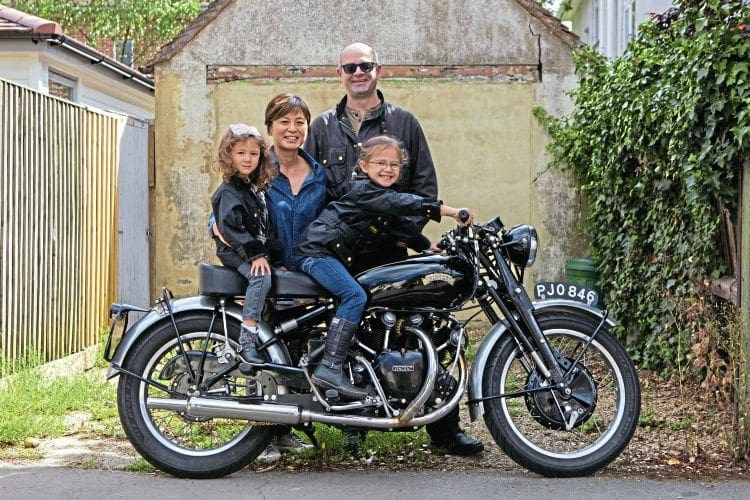
Nigel, wife Toko and children Maggie (on the pillion) and Rosie at the controls. Note the extended footrests!
He has basically rebuilt the entire bike, but in gradual phases. In fact, the bike spent so much time in France my mates said it would need to re-learn English on its return!”
There is an Alton alternator (via Godet) while the Vincent sports two ‘front’ cylinder heads, a popular performance mod in period.
Originally, Nigel was running with a pair of brass-bodied 289 Amals but after the Vincent caught fire, he decided to change to twin Mikunis… He explains: “It spat back through the carb and the next thing I knew it was on fire. It was difficult to know what to do at that point… It was covered in fire extinguisher powder but luckily the damage wasn’t too bad.”
Soon, the Vincent was retuned to fitness, but this time it was sporting Japanese carburettors, which Godet set up on his rolling road, the bike temporarily fitted with gas analysers, though Nigel still has the Amals ‘on the shelf.’
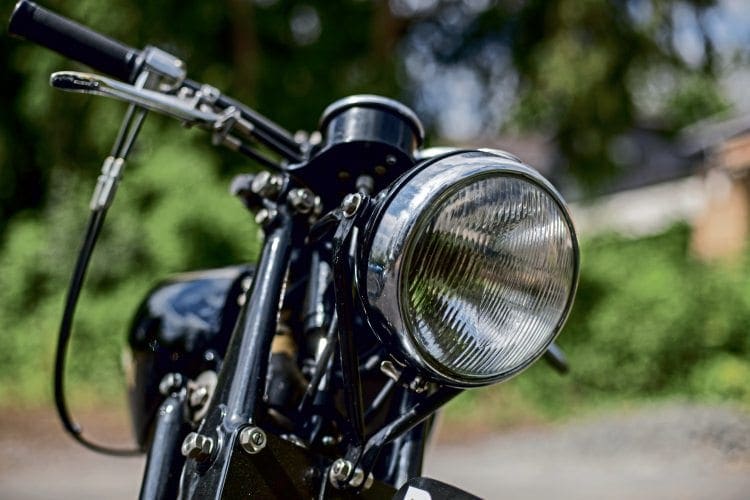
The cable routing may look untidy, but it is deliberate. With two front heads and Mikuni carbs, a smooth passage is not straightforward.
In total since it went back on the road in 2006 Nigel reckons the Vincent has done something around 3000 miles and strangely he’s never had to charge the battery (an Odyssey-made item) once, which says something for the French ignition and charging set-up, as well as the battery’s manufacturing quality.
The Vincent sports 18-inch rims front and rear, with Avon Road Rider tyres, though originally Nigel had it on standard rims, but decided to swap.
Missing components included the wheels; in fact, the front wheel that came with it had two half-width Goldie-type hubs welded together, but Nigel had something else rather special on the shelf, a Dave Degens/Dresda magnesium MV Agusta replica front brake, which was in a classic racer he used to campaign. Of the brake Nigel says: “It’s still good, but not as great as it once was.”
This Vincent is made for riding and Nigel rides it hard, being a regular attendee at various track day events, including the Beezumph at Cadwell Park and Mallory’s classic festival, among other events.
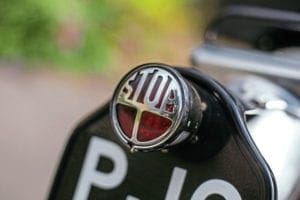
Having raced between 1996 and 2002, Nigel campaigned a host of machinery, ending up with a 500cc Dresda and some backing from proprietor Dave Degens.
But he gave up racing, as by 2002 he was campaigning two bikes and as he admits he “just couldn’t get them right.” He’s a busy man – formerly in the employ of Toyota, he is currently working as an engineering consultant with Mercedes, spending quite a lot of his time in Stuttgart – and such a career isn’t conducive to a sustained racing effort.
In fact, Nigel quit midway through the 2002 campaign, with the intention of getting the two bikes ‘sorted’ and coming back in 2003. In fact, he simply never went back to it.
Nigel has had a huge variety of machines, ranging from prewar Triumphs to modern superbikes, but now he is signed up to a simple philosophy – the Vincent shares his garage with just one other motorcycle, his collection having grown to 10 a few years ago.
But as he correctly opines, it is basically impossible to keep that many bikes in fettle as well as having a full-time job (that involves lots of time away) and maintaining a sense of balance with family life, too.
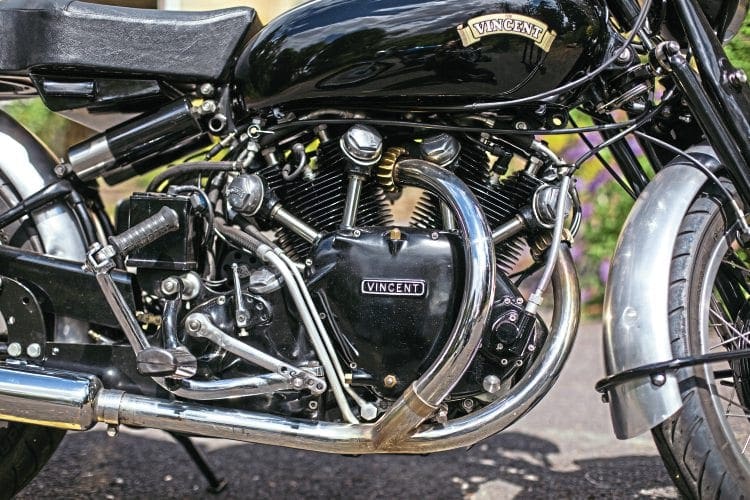
The Vincent V-twin engine. A true design classic.
So he devotes his limited spare time to keeping his Vincent and the other garage occupant in as good a fettle as he is able to. And having ridden both his bikes, it’s a philosophy that seems to work well.
Despite the fact Nigel and I both reckoned his incredibly well-sorted and tweaked Commando (of which we will hear more at a later date) is the nicer bike to ride, the Vincent is of course giving away 25 years to the parallel twin, which needs to be kept in mind.
For some reason Vincents are rarely compared to any of their contemporaries, instead having ‘modern’ or later values imposed upon them.
But if you consider that at the time of its launch the Vincent was so unlike and ahead of everything else on offer, then the whole ‘thing’ starts to make sense.

Twin clocks are both quick to spin round…
And it is a testament to the marque’s quality that they are compared to later machines because, frankly, they are incomparable to any of their contemporaries.
What’s it like to ride?
Sat astride a Vincent feels unlike all other machines. Not only are the Stevenage-built machines ploughing their own furrow in terms of design, once aboard one could be on nothing else. T
he seat (this one came from marque specialist Bob Culver, incidentally) feels high and wide, while the trademark Vincent flat bars feel low.
Standard Vincent bars always feel narrow, though I suspect Nigel’s may be a touch wider than standard. Nigel instructs me in the starting drill – ignition on, press down the cold start (choke) lever, a few kicks with the valve lifter in, then kick while simultaneously releasing the valve lift and a little bit of throttle.
Like any motorcycle known well by its owner, Nigel makes it look easy, but it takes me a couple of attempts to find the correct throttle opening when kicking. But it starts easy enough thereafter.

The English countryside and a Vincent twin constitutes a great day out!
Nigel’s Vincent’s throttle action is impressively light compared to other twins I’ve sampled, while the clutch is smooth and progressive too and not a bit heavy, either.
Setting off, I do my customary front brake test – this one feels pretty good, always reassuring. We head straight out into heavy town traffic and set about filtering through.
Now, this can always be a little nerve-wracking in an unfamiliar city on an unfamiliar motorcycle, but the Vincent is pleasant, docile and tractable, though its bark ensures any car driver not paying attention soon is.
Out onto the bypass and its time to give it its head. And it is brilliant. Soon, the Vincent feels familiar and solid, as we ‘drag race’ away from lights before pulling up to the next set. I can see why Nigel uses it on track. I can also see him grinning at me as he glances back. We’re having fun.

The purposeful looking Vincent at rest.
Away from the traffic light GP, we ride into the countryside.
By now, the Vincent riding position is feeling natural, while I’m relishing the five-speed gearbox too, though first gear is perhaps a touch on the tall side when pulling away, which eventually means the clutch gets a bit hot and bothered as we do several stop/starts for photographs.
Nigel has encouraged me to rev the Vincent plenty and it responds magnificently, accompanied by a thrumming boom. We get onto single track roads and our pace keeps reasonably brisk – humpback bridges, potholes and high hedges means one’s attention must be kept and though the Vincent doesn’t become overly agitated, it isn’t as settled as Nigel’s Commando, and I’m struggling, slightly in vain, to keep up with the rapid blue missile (and its rapid rider) in front.
We swap bikes for the ride back and I get to follow Nigel on the Vincent.
It’s brilliant, as we tramp round a big, open, wide roundabout, watching the Vin’s right footrests skimming the Tarmac as Nigel maintains his line, with his left hand out indicating we’re coming off the roundabout, all the while the Vincent rear wheel gently going up and down though the machine stays dead true. Impressive to behold.

And that sums this Vincent up all round.
History
Though this Vincent is a fabulous machine it its own right, it also has quite some history too, being the machine owned by legendary journalist and author Bruce Main-Smith (BMS). Bruce did epic mileages on the Vin, while it was also modified extensively – Nigel still has the rear subframe the affectionately-named ‘Pig’ (owing to its appearance, not temperament) was fitted with by BMS.
In fact, the Pig was the subject of a Motor Cycling roadtest in late 1960, which we’ve reproduced over and which makes for interesting reading. I’ll make no further comment on the performance figures quoted than to say I reckon this Vincent still has that in it. Easily.
But as for being a Pig? Not a bit of it.
Read more News and Features in the December 2019 issue of The Classic Motorcycle –on sale now!
A 998cc VINCENT SPECIAL
110mph roadster extensively modified to owner’s requirements
Motorcycling: December 29, 1960
We close the year with a Road Test that is different. It deals with a privately-owned machine of a make which (regrettably, many feel) is no longer in production. The subject is the 10-year-old “Shadowized” Vincent “Rapide” owned by staffman Bruce Main-Smith and modified by him to his personal requirements. Its history includes a spell of solo and sidecar racing. – Ed.
NOW at a mileage of 132,000, Bruce Main-Smith’s 1951 1,000cc ohv V-twin Vincent “Rapide” has been converted by the owner to meet his own priorities.
These demanded the ability to cruise indefinitely on motorways at 90 to 100mph; outstandingly good acceleration and braking to deal with weekend traffic on the A29 and A3/A283 London-South Coast routes; first-class roadholding; protection from the weather; luggage-carrying facilities and especially good lights. Further, the machine had to be as suitable for the owner’s wife on the pillion as it was for the driver.
Accordingly, the following non-standard equipment has been fitted, some of it of the owner’s design and construction: “Shadowized” engine with “Picador” two-start oil-pump worm, doubling the rate of circulation; “Lightning” brakes; “conventional” swinging-fork rear suspension; an “Avon Streamliner” full-frontal fairing; qd panniers and luggage carrier and an AMC twinseat.
The immediate impression on seeing “Pig”—as the Main-Smiths call it—is of cumbersomeness. This was not dissipated when one wheeled the machine around. Steering lock was restricted, even below the limited Vincent standard, and the frontal overhang was a nuisance.
Against this, the enclosure was completely successful in keeping the rider clean and dry – even his hands and feet – and in relieving him of fatiguing wind pressure. (The Vincent “leaning on the wind” position has been eliminated by moving the footrests forward and fitting Ariel handlebars.) At speed, goggles were necessary.
The passenger received some air buffeting, though less than on a “naked” model. Really fast cruising in rain was practical. Water could not pass the front-fork gaiter. Internal leg panels tidy up the enclosure, allow the stiffening boxes to be used to carry full puncture and chain repair outfits, and direct air more onto the cylinders. Either shield could be taken off in 30 sec.
Diminished cooling by radiation made the engine run hotter than standard at low air speeds – without, apparently, any ill effects. A pleasant warmth was imparted in the wintry test period; in summer, the owner’s riding kit consists of sports jacket and flannels, with light outerwear for rain.
Once under power, the steering was faultless.

There was no heaviness at low speeds. Although the standard steering damper had been removed, the Vincent was 100% wobble-free, even when thrust hard over bumpy roads. It never nodded its head or wagged its tail.
There was undiminished ground clearance. The enclosure could not be touched down.
In the wet, sheer weight aided adhesion, the mount being both quick and extremely safe.
Roadholding was equal to that of any mount in current production.
Indeed, it was “Grand Touring” in the car sense of the term. The ride was exceptionally comfortable for this level of handling, the Girdraulic front forks making a major contribution.
Behaviour was free from pitching or any associated faults. There was no change of trim, no matter how hard the excellent brakes were applied. Application of the nominal 55 “brake horses” produced only a trace of lifting at the front; jack-knifing at the rear pivot, not unknown on standard Vincents, was completely absent.
The front forks clicked on being moved from lock to lock, indicating wear at the eccentrics. The metal-bush-pivoted rear fork was rigid laterally. The use of closed lug ends in this component, however, made rear wheel removal complicated and messy.
Steering generally was a revelation for a mount weighing 540lb, conceived in 1945 and home modified. A pillion passenger was no handicap—if anything, an asset. The front forks have Series ‘D’ trail limits, an Armstrong hydraulic unit and one Norton clutch spring supplementing each inner main spring.

Tailored for two, the Main-Smith Vincent has the power and the handling properties of an ideal pillion machine.
The tailored riding position proved perfect for a man of much the same size and build as the owner. The tank could be both narrower, to reduce splay at the knees, and larger, to hold more than 3 gal.
The fixed footrests were just right; both their associated pedals, modified to suit, were well-placed. The pillion rests have been lengthened and cranked for the comfort of a 5-ft 1-in passenger.
With the flexibility and output of a “Shadow”– type engine, the machine had an abundance of smooth power. The crankshaft, Hartley balanced, mounts Irving-designed caged big-ends.
A continuous motorway cruise in the upper nineties revealed no vibration. But there was a protracted period, in the forties in second and fifties in third, which produced tremor rather than vibratio – an effect probably accentuated by the general smoothness. Top gear could be held down to 35mph, below which speed the extra backlash suggested a change down.
What optimum use of the gears could achieve is shown, strikingly enough, by the graph and tabulated figures; but under road conditions change-points were by no means critical.
Although third could be held to 90 or even 100mph, this was quite unnecessary. The machine has been fettled to give shattering acceleration in top gear at 45mph. Good results were forthcoming at 40; at about 43 one felt everything get into phase – then one had to hold on very tight. And pick-up persisted at 100 if the half-open throttles were suddenly fully lifted.
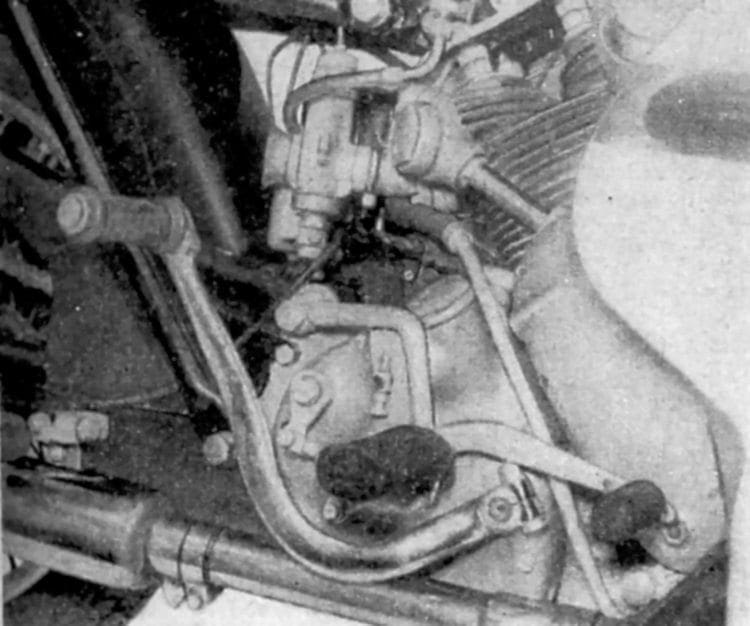
The modified kickstarter crank can be used without fouling either the footrest (also modified) or pillion rest. The carburetter top has been enlarged to take softer springs.
The gearbox has the low “Rapide” bottom. Top and third have been given extra backlash. Also non-standard is the multi-plate dry clutch, made from Norton parts.
This combination gave faultless gear-changes. A Vincent can be stiff to put into top around 90mph, but this did not occur. Neutral was easily found from bottom or second. The gear pedal, however, had too long a travel.
The clutch was excellent, light and jerk-free. There was no overheating, slipping or need for adjustment during the test.
Carburation was unhesitant throughout. The modified mixing chambers permitted light wrist action. General fuel consumption was 53mpg over an extended period of really hard driving. “Super” grade petrol was essential to avoid pinking.
Main jet size is 190 instead of 180 to promote reliability at prolonged high speeds. PJO 846 has not been recently decoked – in accordance with the widespread belief that this process is simply unnecessary with a “1000” Vincent.
The handbook advice of “straight” oils – SAE 50 summer, 30 winter – is normally followed. In deference to the high-speed work at MIRA, we kept to heavy oil this month and paid the penalty with an engine stiff to crank when cold.

Fixed main footrest and modified brake pedal are details seen in this nearside view. Both crankcase breather pipes enter the pannier rail so that discharge occurs at the machine’s rearmost point.
No chokes are fitted, nor were they needed; a good flood was enough. The rear float-chamber is sensibly mounted on the left so that the petrol may be left on when the prop-stand is used; its tickler is extended for easy access.
The standard Vincent drill of raising the footrest before kickstarting was not necessary; the pedal-piece to the rebent crank is fixed permanently out; it did not foul the leg.
Vincent braking has always been superb and indeed set the road-test record for a long time. The “Lightning” racing anchors on this mount were first-class.
Pedal pressure on the single drum back stopper was less than standard for the marque. Neither it nor the Ferodo-lined dual front brake were affected by heat or rain.
The Marchal lights were admirable, especially the asymmetrical cut-off to the dipped beam of the headlamp, the set of which is adjustable from the saddle to compensate for load. The “flamethrower” spot is aimed 30yd ahead, aligned on the verge of the centre strip of the M1. The fog lamp gave a spread pattern at short range.
The note of the twin Lucas Windtone horns, set to fire up the left airscoop, was lethal at 150 yd during 90mph motorway cruising. Boosted dynamo output kept the battery up, though charging as heavy as 8 amp, was seen at times.
The power unit was oiltight with the exception of the kickstarter cover, a “dry” compartment anyway! Oil consumption however, was high at 200 miles per pint.
There was considerable engine-to-chaincase transference, which called for levelling and probably accounted for most of the oil loss. KLG FE75 plugs were used. They never fouled, even in prolonged central-work (inlet valve and rocker drainage been improved).
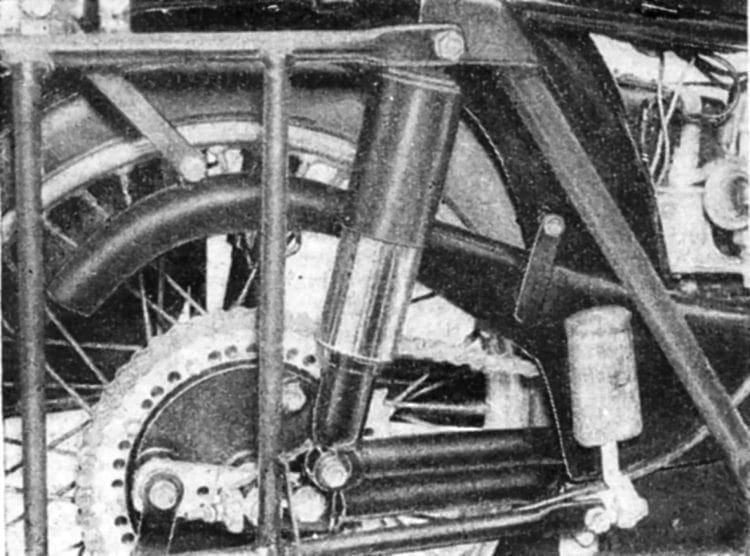
The home-brewed swinging-fork rear end, with Armstrong damper. The axle lug is cut from solid high-tensile steel. The pannier frame is q.d.; the wheel is not.
Exhaust silencing was up to the usual Vincent standard, which is good. Mechanically, the engine was clattery, but wear may account for some of this;. For example the cams are the originals. There was slap from the cylinder group, which has some 90,000 miles and is due for renewal.
Many detail points are worthy of comment. The special prop-stand is excellent – easily found with the foot, always supporting the machine firmly and tucking up well.
The centre-stand is really repair-maintenance equipment, so its heavy lift may be overlooked. Neither grounds on corners. Regrettably, there is no front stand, so a small jack is carried.
The handlebar mirror is free from vibration blur and was a boon. The speedometer, which had been regeared to remove optimism, was accurate. There are 16 attachment points for elastics on the luggage equipment.
To sum up. Here is a 1945-designed, 1951-built machine that has been modified for a particular purpose.
The success of those modifications in dealing with certain known Vincent shortcomings provokes, inevitably, thoughts of the mount that Stevenage might have been producing today – and points sadly to the gap left in the British production pattern by the death of the big twin.
SPECIFICATION
ENGINE
Type 50° V-twin four-stroke
Bore 84mm
Stroke 90mm
Cubic capacity 998cc
Valves Overhead (push-rod)
Compression ratio 7.3:1
Carburetters Amal 1⅛-in bore “289”
Ignition Lucas magneto with automatic control
Generator Lucas E3L 6-v 60-w dynamo with AVC and boosted output
Makers’ claimed output 55bhp/5500rpm
Lubrication Dry sump with double-output
rotating-plunger pumps
Starting Kickstarter
TRANSMISSION
In-unit gearbox with footchange
Ratios (48t. rear sprocket) 3.7, 4.4, 5.9, 9.4
Speed at 1000 rpm in top gear 21mph
Speed equivalent to revs at maximum power rating:
Second gear 73mph
Third gear 100mph
Top gear 118 mph
Primary drive Triple-row chain in oil bath
Final drive Single-row exposed chain
(both chains by Renold)
Clutch Norton multi-plate in “dry” compartment
Shock-absorber Spring-and-cam type on engine shaft
CYCLE PARTS
Frame Box-type backbone with powerunit as structural member; bolted on sub-frame.
Front suspension Girdraulic forks modified enclosed coil springs; two-way Armstrong hydraulic damper
with limit stops.
Rear suspension Swinging-fork with hydraulically-damped Armstrong units; 85-lb springs. Wheelbase 53in.
Tyres Dunlop ribbed 3.25 x 19-in front,
studded 3.50X19-in rear, both held
by security bolts and balanced .
Brakes Duo front, single rear, all 7-in dia. racing parts. Total lining area, 30 sq in
Fuel tank 3½ gallon; two taps
Oil tank Hollow upper frame member, 6 pints
Lamps Marchal: 45/36-w. adjustable head, 48-w spot, 48-w fog. Lucas: twin 6-w side. 18/6-w, stop/tail, one 3-w speedometer
Horns Twin Lucas Windtone
Battery Lucas 12ah
Speedometer Smiths modified130 mph with trip
Seating AMC q.d. two-level twinseat
Stands Centre, prop, front ink
Toolkit Too large to list; includes
full tyre and chain repair equipment
Toolbox Open compartment beneath seat
Finish Black cycle parts, power
unit in natural alloy, glass fibre enclosure in silver with
black trimmings; usual parts chromium or cadmium plated

OTHER EQUIPMENT
Modified Avon Streamliner; q.d. panniers rear carrier; Triumph tank-top luggage grid; tyre pump; special engine breather; pillion footrests; oil-temperature gauge; mirror
PRICES
Machine Listed in 1951 at £336 11s
(inc £71 11s PT)
Tax £3 15s pa (£1 7s for four months)
Makers Known in February, 1951 as
Vincent-HRD Co Ltd, Stevenage, Herts, now
Harpers Engines Ltd of same address
MOTORCYCLING TEST DATA
Conditions. Weather: Dry, cold (Barometer 29.85Hg Thermometer 36°F). Wind: N, 8-10 mph Surface (braking and acceleration): Dry asphalt. Rider: 11½ stone, 5 ft 10½ in, wearing two-piece suit, safety helmet, normally seated behind screen throughout. Fuel: “Super” grade (101 Research Method Octane Rating).
Venue: Motor Industry Research Association Station, Lindley.
Speed at end of standing 1000 yd:
East 102mph
West 94mph
Best certified MIRA, maximum
(rider upright behind screen) 109mph
Braking from 30mph (all brakes): 9½ yd
Fuel consumption:
At constant 50mph 60mpg
70mph 46mpg
500-mile overall figure 53mpg
Speedometer
30mph indicated = 30.5mph true
40mph indicated = 40.3mph true
50mph, indicated = 50.1mph true
60mph indicated = 60.4mph true
70mph indicated = 70.5mph true
80mph indicated = 80.4mph true
90mph indicated = 91.9 mph true
100mph indicated = 101.8mph true
110mph indicated = 110.8mph true
Mileage Recorder Over-reading ½%
Electrical Equipment
Top gear speed at which generator output balances:
Minimum obligatory lights 28mph
Headlamp main beam 36mph
Headlamp and either spot Not capable
Weights and Capacities
Certified kerbside weight (with oil and 1 gal fuel) 540lb
Weight distribution, rider normally seated:
Front wheel 43%
Rear wheel 57%
Tank capacity (metered):
Total 3⅛ gal
Reserve 1¾ or 6½ pints
Read more News and Features in the December 2019 issue of The Classic Motorcycle –on sale now!
Though it was once known as ‘The Pig’, today this Vincent is anything but. In its early days it endured a hard life – and continues to be ridden with spirit.
Words: James Robinson Photography: GARY CHAPMAN
Occasionally, things can take many years to come to gestation.
This Vincent seems to be a motorcycle that this happens to on a regular basis. For example, its build took much longer than owner Nigel Waring was planning (the build was over seven years), while Nigel and I have been talking for what seems like years about getting this feature together.
But, in both cases (Nigel’s and mine) it has been proved to be well worth the wait.
Despite all the hype, the reputation, the stories and the mythology surrounding the name, the fact is that with regards to a Vincent twin, it doesn’t disappoint, as there really is nothing like it.
As Nigel and I stood looking at his Vincent, parked up outside a disused Masonic lodge, we both mused and mulled over the whole Vincent ‘thing.’
The hows, whys and wherefores can be discussed and debated for ever and ever, but the simple and basic fact is that when the first post Second World War (so Series B) Rapide emerged onto the scene in 1946, it was a machine that boasted performance on a par with the best motorcycles being raced in the top class of world racing, while it was also the premier long-distance tourer out there too.
It was capable of being used as a commuter too, of hauling a sidecar laden with children, suitable for a spot of road racing, sprinting or hillclimbing.
A real all-rounder, but a top, high class one. Add to the mix that physically it was about the same size as said 500cc race machines and it was also a marvel of engineering free-thinking (such as using the engine as a main part of the frame, dual brakes, unit-construction) and really it is impossible to appreciate how different, how avant garde and how darned-right fabulous the Vincent was and is.

And despite the fact that the Vincent twin in its Series B, C and D incarnations (which all share an obvious, common lineage – the prewar A doesn’t so much) lasted for less than 10 years, it has remained an idol and icon of British motorcycling, still possessing an aura which no other machine matches, 60 years since the last of the 6772 (figures do vary, but that seems to be the most regularly quoted) B, C and D twins built rolled off the Stevenage work benches.
Nigel acquired his Vincent about 15 years ago, when a mate and he bought a pair of twins, with Nigel having the one in the worse condition. There was a fair amount of stuff missing, though Nigel didn’t necessarily see that as a curse. “I just thought, I’ll do what I like then.”
And he duly has. The Vincent has retained a relatively standard appearance, but plenty of elements have been uprated, though Nigel decided to replace the swinging-arm rear frame fitted with a B rear frame member that came with the kit.
But though the engine looks outwardly fairly standard, underneath the black-finished engines and gearbox casings, there nestles a five-speed gearbox cluster, which is a Quaife one, acquired through John Surtees.
The engine itself has been heavily breathed upon too, with Lightning (the 150mph ‘racer’ as made famous by Rollie Free on the Bonneville Salt Flats) cams, 8:1 compression ratio pistons, a Francois Grosset ignition system, then several bits from marque specialists Maughan and Sons too, including their dry clutch and crank assembly.
Nigel wishes to extend special platitudes to Maughans, as well as Frenchman Patrick Godet – both have provided many parts, much help and encouragement. Of Patrick, Nigel says: “Although things sometimes take longer than expected, Patrick’s devotion, emotion, craftmanship, knowledge and attention to detail are absolutely second to none.

Nigel, wife Toko and children Maggie (on the pillion) and Rosie at the controls. Note the extended footrests!
He has basically rebuilt the entire bike, but in gradual phases. In fact, the bike spent so much time in France my mates said it would need to re-learn English on its return!”
There is an Alton alternator (via Godet) while the Vincent sports two ‘front’ cylinder heads, a popular performance mod in period.
Originally, Nigel was running with a pair of brass-bodied 289 Amals but after the Vincent caught fire, he decided to change to twin Mikunis… He explains: “It spat back through the carb and the next thing I knew it was on fire. It was difficult to know what to do at that point… It was covered in fire extinguisher powder but luckily the damage wasn’t too bad.”
Soon, the Vincent was retuned to fitness, but this time it was sporting Japanese carburettors, which Godet set up on his rolling road, the bike temporarily fitted with gas analysers, though Nigel still has the Amals ‘on the shelf.’

The cable routing may look untidy, but it is deliberate. With two front heads and Mikuni carbs, a smooth passage is not straightforward.
In total since it went back on the road in 2006 Nigel reckons the Vincent has done something around 3000 miles and strangely he’s never had to charge the battery (an Odyssey-made item) once, which says something for the French ignition and charging set-up, as well as the battery’s manufacturing quality.
The Vincent sports 18-inch rims front and rear, with Avon Road Rider tyres, though originally Nigel had it on standard rims, but decided to swap.
Missing components included the wheels; in fact, the front wheel that came with it had two half-width Goldie-type hubs welded together, but Nigel had something else rather special on the shelf, a Dave Degens/Dresda magnesium MV Agusta replica front brake, which was in a classic racer he used to campaign. Of the brake Nigel says: “It’s still good, but not as great as it once was.”
This Vincent is made for riding and Nigel rides it hard, being a regular attendee at various track day events, including the Beezumph at Cadwell Park and Mallory’s classic festival, among other events.

Having raced between 1996 and 2002, Nigel campaigned a host of machinery, ending up with a 500cc Dresda and some backing from proprietor Dave Degens.
But he gave up racing, as by 2002 he was campaigning two bikes and as he admits he “just couldn’t get them right.” He’s a busy man – formerly in the employ of Toyota, he is currently working as an engineering consultant with Mercedes, spending quite a lot of his time in Stuttgart – and such a career isn’t conducive to a sustained racing effort.
In fact, Nigel quit midway through the 2002 campaign, with the intention of getting the two bikes ‘sorted’ and coming back in 2003. In fact, he simply never went back to it.
Nigel has had a huge variety of machines, ranging from prewar Triumphs to modern superbikes, but now he is signed up to a simple philosophy – the Vincent shares his garage with just one other motorcycle, his collection having grown to 10 a few years ago.
But as he correctly opines, it is basically impossible to keep that many bikes in fettle as well as having a full-time job (that involves lots of time away) and maintaining a sense of balance with family life, too.

The Vincent V-twin engine. A true design classic.
So he devotes his limited spare time to keeping his Vincent and the other garage occupant in as good a fettle as he is able to. And having ridden both his bikes, it’s a philosophy that seems to work well.
Despite the fact Nigel and I both reckoned his incredibly well-sorted and tweaked Commando (of which we will hear more at a later date) is the nicer bike to ride, the Vincent is of course giving away 25 years to the parallel twin, which needs to be kept in mind.
For some reason Vincents are rarely compared to any of their contemporaries, instead having ‘modern’ or later values imposed upon them.
But if you consider that at the time of its launch the Vincent was so unlike and ahead of everything else on offer, then the whole ‘thing’ starts to make sense.

Twin clocks are both quick to spin round…
And it is a testament to the marque’s quality that they are compared to later machines because, frankly, they are incomparable to any of their contemporaries.
What’s it like to ride?
Sat astride a Vincent feels unlike all other machines. Not only are the Stevenage-built machines ploughing their own furrow in terms of design, once aboard one could be on nothing else. T
he seat (this one came from marque specialist Bob Culver, incidentally) feels high and wide, while the trademark Vincent flat bars feel low.
Standard Vincent bars always feel narrow, though I suspect Nigel’s may be a touch wider than standard. Nigel instructs me in the starting drill – ignition on, press down the cold start (choke) lever, a few kicks with the valve lifter in, then kick while simultaneously releasing the valve lift and a little bit of throttle.
Like any motorcycle known well by its owner, Nigel makes it look easy, but it takes me a couple of attempts to find the correct throttle opening when kicking. But it starts easy enough thereafter.

The English countryside and a Vincent twin constitutes a great day out!
Nigel’s Vincent’s throttle action is impressively light compared to other twins I’ve sampled, while the clutch is smooth and progressive too and not a bit heavy, either.
Setting off, I do my customary front brake test – this one feels pretty good, always reassuring. We head straight out into heavy town traffic and set about filtering through.
Now, this can always be a little nerve-wracking in an unfamiliar city on an unfamiliar motorcycle, but the Vincent is pleasant, docile and tractable, though its bark ensures any car driver not paying attention soon is.
Out onto the bypass and its time to give it its head. And it is brilliant. Soon, the Vincent feels familiar and solid, as we ‘drag race’ away from lights before pulling up to the next set. I can see why Nigel uses it on track. I can also see him grinning at me as he glances back. We’re having fun.

The purposeful looking Vincent at rest.
Away from the traffic light GP, we ride into the countryside.
By now, the Vincent riding position is feeling natural, while I’m relishing the five-speed gearbox too, though first gear is perhaps a touch on the tall side when pulling away, which eventually means the clutch gets a bit hot and bothered as we do several stop/starts for photographs.
Nigel has encouraged me to rev the Vincent plenty and it responds magnificently, accompanied by a thrumming boom. We get onto single track roads and our pace keeps reasonably brisk – humpback bridges, potholes and high hedges means one’s attention must be kept and though the Vincent doesn’t become overly agitated, it isn’t as settled as Nigel’s Commando, and I’m struggling, slightly in vain, to keep up with the rapid blue missile (and its rapid rider) in front.
We swap bikes for the ride back and I get to follow Nigel on the Vincent.
It’s brilliant, as we tramp round a big, open, wide roundabout, watching the Vin’s right footrests skimming the Tarmac as Nigel maintains his line, with his left hand out indicating we’re coming off the roundabout, all the while the Vincent rear wheel gently going up and down though the machine stays dead true. Impressive to behold.

And that sums this Vincent up all round.
History
Though this Vincent is a fabulous machine it its own right, it also has quite some history too, being the machine owned by legendary journalist and author Bruce Main-Smith (BMS). Bruce did epic mileages on the Vin, while it was also modified extensively – Nigel still has the rear subframe the affectionately-named ‘Pig’ (owing to its appearance, not temperament) was fitted with by BMS.
In fact, the Pig was the subject of a Motor Cycling roadtest in late 1960, which we’ve reproduced over and which makes for interesting reading. I’ll make no further comment on the performance figures quoted than to say I reckon this Vincent still has that in it. Easily.
But as for being a Pig? Not a bit of it.
Read more News and Features in the December 2019 issue of The Classic Motorcycle –on sale now!
A 998cc VINCENT SPECIAL
110mph roadster extensively modified to owner’s requirements
Motorcycling: December 29, 1960
We close the year with a Road Test that is different. It deals with a privately-owned machine of a make which (regrettably, many feel) is no longer in production. The subject is the 10-year-old “Shadowized” Vincent “Rapide” owned by staffman Bruce Main-Smith and modified by him to his personal requirements. Its history includes a spell of solo and sidecar racing. – Ed.
NOW at a mileage of 132,000, Bruce Main-Smith’s 1951 1,000cc ohv V-twin Vincent “Rapide” has been converted by the owner to meet his own priorities.
These demanded the ability to cruise indefinitely on motorways at 90 to 100mph; outstandingly good acceleration and braking to deal with weekend traffic on the A29 and A3/A283 London-South Coast routes; first-class roadholding; protection from the weather; luggage-carrying facilities and especially good lights. Further, the machine had to be as suitable for the owner’s wife on the pillion as it was for the driver.
Accordingly, the following non-standard equipment has been fitted, some of it of the owner’s design and construction: “Shadowized” engine with “Picador” two-start oil-pump worm, doubling the rate of circulation; “Lightning” brakes; “conventional” swinging-fork rear suspension; an “Avon Streamliner” full-frontal fairing; qd panniers and luggage carrier and an AMC twinseat.
The immediate impression on seeing “Pig”—as the Main-Smiths call it—is of cumbersomeness. This was not dissipated when one wheeled the machine around. Steering lock was restricted, even below the limited Vincent standard, and the frontal overhang was a nuisance.
Against this, the enclosure was completely successful in keeping the rider clean and dry – even his hands and feet – and in relieving him of fatiguing wind pressure. (The Vincent “leaning on the wind” position has been eliminated by moving the footrests forward and fitting Ariel handlebars.) At speed, goggles were necessary.
The passenger received some air buffeting, though less than on a “naked” model. Really fast cruising in rain was practical. Water could not pass the front-fork gaiter. Internal leg panels tidy up the enclosure, allow the stiffening boxes to be used to carry full puncture and chain repair outfits, and direct air more onto the cylinders. Either shield could be taken off in 30 sec.
Diminished cooling by radiation made the engine run hotter than standard at low air speeds – without, apparently, any ill effects. A pleasant warmth was imparted in the wintry test period; in summer, the owner’s riding kit consists of sports jacket and flannels, with light outerwear for rain.
Once under power, the steering was faultless.

There was no heaviness at low speeds. Although the standard steering damper had been removed, the Vincent was 100% wobble-free, even when thrust hard over bumpy roads. It never nodded its head or wagged its tail.
There was undiminished ground clearance. The enclosure could not be touched down.
In the wet, sheer weight aided adhesion, the mount being both quick and extremely safe.
Roadholding was equal to that of any mount in current production.
Indeed, it was “Grand Touring” in the car sense of the term. The ride was exceptionally comfortable for this level of handling, the Girdraulic front forks making a major contribution.
Behaviour was free from pitching or any associated faults. There was no change of trim, no matter how hard the excellent brakes were applied. Application of the nominal 55 “brake horses” produced only a trace of lifting at the front; jack-knifing at the rear pivot, not unknown on standard Vincents, was completely absent.
The front forks clicked on being moved from lock to lock, indicating wear at the eccentrics. The metal-bush-pivoted rear fork was rigid laterally. The use of closed lug ends in this component, however, made rear wheel removal complicated and messy.
Steering generally was a revelation for a mount weighing 540lb, conceived in 1945 and home modified. A pillion passenger was no handicap—if anything, an asset. The front forks have Series ‘D’ trail limits, an Armstrong hydraulic unit and one Norton clutch spring supplementing each inner main spring.

Tailored for two, the Main-Smith Vincent has the power and the handling properties of an ideal pillion machine.
The tailored riding position proved perfect for a man of much the same size and build as the owner. The tank could be both narrower, to reduce splay at the knees, and larger, to hold more than 3 gal.
The fixed footrests were just right; both their associated pedals, modified to suit, were well-placed. The pillion rests have been lengthened and cranked for the comfort of a 5-ft 1-in passenger.
With the flexibility and output of a “Shadow”– type engine, the machine had an abundance of smooth power. The crankshaft, Hartley balanced, mounts Irving-designed caged big-ends.
A continuous motorway cruise in the upper nineties revealed no vibration. But there was a protracted period, in the forties in second and fifties in third, which produced tremor rather than vibratio – an effect probably accentuated by the general smoothness. Top gear could be held down to 35mph, below which speed the extra backlash suggested a change down.
What optimum use of the gears could achieve is shown, strikingly enough, by the graph and tabulated figures; but under road conditions change-points were by no means critical.
Although third could be held to 90 or even 100mph, this was quite unnecessary. The machine has been fettled to give shattering acceleration in top gear at 45mph. Good results were forthcoming at 40; at about 43 one felt everything get into phase – then one had to hold on very tight. And pick-up persisted at 100 if the half-open throttles were suddenly fully lifted.

The modified kickstarter crank can be used without fouling either the footrest (also modified) or pillion rest. The carburetter top has been enlarged to take softer springs.
The gearbox has the low “Rapide” bottom. Top and third have been given extra backlash. Also non-standard is the multi-plate dry clutch, made from Norton parts.
This combination gave faultless gear-changes. A Vincent can be stiff to put into top around 90mph, but this did not occur. Neutral was easily found from bottom or second. The gear pedal, however, had too long a travel.
The clutch was excellent, light and jerk-free. There was no overheating, slipping or need for adjustment during the test.
Carburation was unhesitant throughout. The modified mixing chambers permitted light wrist action. General fuel consumption was 53mpg over an extended period of really hard driving. “Super” grade petrol was essential to avoid pinking.
Main jet size is 190 instead of 180 to promote reliability at prolonged high speeds. PJO 846 has not been recently decoked – in accordance with the widespread belief that this process is simply unnecessary with a “1000” Vincent.
The handbook advice of “straight” oils – SAE 50 summer, 30 winter – is normally followed. In deference to the high-speed work at MIRA, we kept to heavy oil this month and paid the penalty with an engine stiff to crank when cold.

Fixed main footrest and modified brake pedal are details seen in this nearside view. Both crankcase breather pipes enter the pannier rail so that discharge occurs at the machine’s rearmost point.
No chokes are fitted, nor were they needed; a good flood was enough. The rear float-chamber is sensibly mounted on the left so that the petrol may be left on when the prop-stand is used; its tickler is extended for easy access.
The standard Vincent drill of raising the footrest before kickstarting was not necessary; the pedal-piece to the rebent crank is fixed permanently out; it did not foul the leg.
Vincent braking has always been superb and indeed set the road-test record for a long time. The “Lightning” racing anchors on this mount were first-class.
Pedal pressure on the single drum back stopper was less than standard for the marque. Neither it nor the Ferodo-lined dual front brake were affected by heat or rain.
The Marchal lights were admirable, especially the asymmetrical cut-off to the dipped beam of the headlamp, the set of which is adjustable from the saddle to compensate for load. The “flamethrower” spot is aimed 30yd ahead, aligned on the verge of the centre strip of the M1. The fog lamp gave a spread pattern at short range.
The note of the twin Lucas Windtone horns, set to fire up the left airscoop, was lethal at 150 yd during 90mph motorway cruising. Boosted dynamo output kept the battery up, though charging as heavy as 8 amp, was seen at times.
The power unit was oiltight with the exception of the kickstarter cover, a “dry” compartment anyway! Oil consumption however, was high at 200 miles per pint.
There was considerable engine-to-chaincase transference, which called for levelling and probably accounted for most of the oil loss. KLG FE75 plugs were used. They never fouled, even in prolonged central-work (inlet valve and rocker drainage been improved).

The home-brewed swinging-fork rear end, with Armstrong damper. The axle lug is cut from solid high-tensile steel. The pannier frame is q.d.; the wheel is not.
Exhaust silencing was up to the usual Vincent standard, which is good. Mechanically, the engine was clattery, but wear may account for some of this;. For example the cams are the originals. There was slap from the cylinder group, which has some 90,000 miles and is due for renewal.
Many detail points are worthy of comment. The special prop-stand is excellent – easily found with the foot, always supporting the machine firmly and tucking up well.
The centre-stand is really repair-maintenance equipment, so its heavy lift may be overlooked. Neither grounds on corners. Regrettably, there is no front stand, so a small jack is carried.
The handlebar mirror is free from vibration blur and was a boon. The speedometer, which had been regeared to remove optimism, was accurate. There are 16 attachment points for elastics on the luggage equipment.
To sum up. Here is a 1945-designed, 1951-built machine that has been modified for a particular purpose.
The success of those modifications in dealing with certain known Vincent shortcomings provokes, inevitably, thoughts of the mount that Stevenage might have been producing today – and points sadly to the gap left in the British production pattern by the death of the big twin.
SPECIFICATION
ENGINE
Type 50° V-twin four-stroke
Bore 84mm
Stroke 90mm
Cubic capacity 998cc
Valves Overhead (push-rod)
Compression ratio 7.3:1
Carburetters Amal 1⅛-in bore “289”
Ignition Lucas magneto with automatic control
Generator Lucas E3L 6-v 60-w dynamo with AVC and boosted output
Makers’ claimed output 55bhp/5500rpm
Lubrication Dry sump with double-output
rotating-plunger pumps
Starting Kickstarter
TRANSMISSION
In-unit gearbox with footchange
Ratios (48t. rear sprocket) 3.7, 4.4, 5.9, 9.4
Speed at 1000 rpm in top gear 21mph
Speed equivalent to revs at maximum power rating:
Second gear 73mph
Third gear 100mph
Top gear 118 mph
Primary drive Triple-row chain in oil bath
Final drive Single-row exposed chain
(both chains by Renold)
Clutch Norton multi-plate in “dry” compartment
Shock-absorber Spring-and-cam type on engine shaft
CYCLE PARTS
Frame Box-type backbone with powerunit as structural member; bolted on sub-frame.
Front suspension Girdraulic forks modified enclosed coil springs; two-way Armstrong hydraulic damper
with limit stops.
Rear suspension Swinging-fork with hydraulically-damped Armstrong units; 85-lb springs. Wheelbase 53in.
Tyres Dunlop ribbed 3.25 x 19-in front,
studded 3.50X19-in rear, both held
by security bolts and balanced .
Brakes Duo front, single rear, all 7-in dia. racing parts. Total lining area, 30 sq in
Fuel tank 3½ gallon; two taps
Oil tank Hollow upper frame member, 6 pints
Lamps Marchal: 45/36-w. adjustable head, 48-w spot, 48-w fog. Lucas: twin 6-w side. 18/6-w, stop/tail, one 3-w speedometer
Horns Twin Lucas Windtone
Battery Lucas 12ah
Speedometer Smiths modified130 mph with trip
Seating AMC q.d. two-level twinseat
Stands Centre, prop, front ink
Toolkit Too large to list; includes
full tyre and chain repair equipment
Toolbox Open compartment beneath seat
Finish Black cycle parts, power
unit in natural alloy, glass fibre enclosure in silver with
black trimmings; usual parts chromium or cadmium plated

OTHER EQUIPMENT
Modified Avon Streamliner; q.d. panniers rear carrier; Triumph tank-top luggage grid; tyre pump; special engine breather; pillion footrests; oil-temperature gauge; mirror
PRICES
Machine Listed in 1951 at £336 11s
(inc £71 11s PT)
Tax £3 15s pa (£1 7s for four months)
Makers Known in February, 1951 as
Vincent-HRD Co Ltd, Stevenage, Herts, now
Harpers Engines Ltd of same address
MOTORCYCLING TEST DATA
Conditions. Weather: Dry, cold (Barometer 29.85Hg Thermometer 36°F). Wind: N, 8-10 mph Surface (braking and acceleration): Dry asphalt. Rider: 11½ stone, 5 ft 10½ in, wearing two-piece suit, safety helmet, normally seated behind screen throughout. Fuel: “Super” grade (101 Research Method Octane Rating).
Venue: Motor Industry Research Association Station, Lindley.
Speed at end of standing 1000 yd:
East 102mph
West 94mph
Best certified MIRA, maximum
(rider upright behind screen) 109mph
Braking from 30mph (all brakes): 9½ yd
Fuel consumption:
At constant 50mph 60mpg
70mph 46mpg
500-mile overall figure 53mpg
Speedometer
30mph indicated = 30.5mph true
40mph indicated = 40.3mph true
50mph, indicated = 50.1mph true
60mph indicated = 60.4mph true
70mph indicated = 70.5mph true
80mph indicated = 80.4mph true
90mph indicated = 91.9 mph true
100mph indicated = 101.8mph true
110mph indicated = 110.8mph true
Mileage Recorder Over-reading ½%
Electrical Equipment
Top gear speed at which generator output balances:
Minimum obligatory lights 28mph
Headlamp main beam 36mph
Headlamp and either spot Not capable
Weights and Capacities
Certified kerbside weight (with oil and 1 gal fuel) 540lb
Weight distribution, rider normally seated:
Front wheel 43%
Rear wheel 57%
Tank capacity (metered):
Total 3⅛ gal
Reserve 1¾ or 6½ pints
Read more News and Features in the December 2019 issue of The Classic Motorcycle –on sale now!
- Local time
- Today, 03:50
- Joined
- Jan 5, 2006
- Messages
- 29,608
- Points
- 1,218
- Age
- 79
- Location
- Dania Beach, Florida
- First Name
- Carl
- My Ride
- 2020 Bonneville T120 Black
- Riding Since
- 1958
I like all of the Vincent models.
- Local time
- Today, 09:50
- Joined
- Jan 5, 2006
- Messages
- 54,198
- Points
- 1,327
- First Name
- Dave
- My Ride
- Speedmaster
- Riding Since
- 1974
Looking for track layouts
Recently a friend and I have been looking for information on the scrambles (motocross) at Brands Hatch. Today, I got round to opening the September 2019 issue of The Classic Motorcycle and, surprise, surprise, was an article on the Motocross des Nations, including Brands Hatch in 1949.
What I am looking for in particular are maps of the various courses used.

Cox, AJS, leaps at Brands in 1949. Does anyone have a plan of the circuit used?
The only one that I have is for the 1966 international in a programme.
There are photos and the odd film of the postwar events but no maps.
Are you or any of your readers aware of any? If there are some out there, then we would be most grateful.
Keep up the good work.
Alan Brown, email alanbrown402@btinternet.com
Read more Letters, Opinion, News and Features in the December 2019 issue of The Classic Motorcycle –on sale now!
Recently a friend and I have been looking for information on the scrambles (motocross) at Brands Hatch. Today, I got round to opening the September 2019 issue of The Classic Motorcycle and, surprise, surprise, was an article on the Motocross des Nations, including Brands Hatch in 1949.
What I am looking for in particular are maps of the various courses used.

Cox, AJS, leaps at Brands in 1949. Does anyone have a plan of the circuit used?
The only one that I have is for the 1966 international in a programme.
There are photos and the odd film of the postwar events but no maps.
Are you or any of your readers aware of any? If there are some out there, then we would be most grateful.
Keep up the good work.
Alan Brown, email alanbrown402@btinternet.com
Read more Letters, Opinion, News and Features in the December 2019 issue of The Classic Motorcycle –on sale now!
- Local time
- Today, 09:50
- Joined
- Jan 5, 2006
- Messages
- 54,198
- Points
- 1,327
- First Name
- Dave
- My Ride
- Speedmaster
- Riding Since
- 1974
100 years of Indian Scout motorcycles!
As 2019 marks the centenary anniversary of the Indian Scout – especially with the release of two new special edition models – there’s no better time to look back at the history of this iconic bike and see how it all began, way back when.

In 1919, Indian motorcycle racer and engineer Charles B. Franklin designed the very first Scout, or G-20, which was introduced as a 2020 model. The G-20 was certainly a hit with US bikers due to its side-valve V-twin engine, allowing for a geared primary drive. It also wiped the floor of 606cc engines in its original incarnation, catapulting the Scout into an industry front-runner.
The engine size had increased to 745cc by 1927 due to the growing popularity of the Excelsior Super X. By the following year a front brake also had been implemented.
After the last adjustments to the original Scout, the 101 Scout appeared in mid-1928, introducing a new frame, a lowered seat height and an extended wheelbase. Many of the 101’s features, including the rear sub-frame and wheelbase, came from the Indian 401, which at the time was still in development.

The 101 Scout offered a 740cc engine and was praised for its handling, becoming the ‘bike to have’ for racers and trick riders. Despite this, it didn’t have a particularly long production run as the Great Depression pushed Indian to the point of bankruptcy, eventually leading the company to be bought out by the DuPont family.
By 1931, to save on resources and cost, the decision was made to design a more economic frame, so with some design changes the new frame was used on Chief and Four, the then latest models in the Scout range, ending production on the 101 Scout.
The following years witnessed a wide variety of designs enter the Scout family, including the Standard (1932-1937), the Thirty-Fifty (1934-1942), the military versions developed for WWII, and the most recent 2015 Scout, plus, of course, the new special edition bikes: the Scout 100th Anniversary and the Scout Bobber Twenty.
Only 750 of these bikes are available. The 100th Anniversary edition’s design is reminiscent of the 101 Scout, donning the memorable Indian motorcycle red paint with gold trimming to complement the anniversary badge. It also has a leather solo seat, luggage rack, black wire wheels and beach bars.

The Bobber, on the other hand, pays homage to the original G-20 with 10-inch Ape Hanger Handlebars, an ergonomic floating saddle and wire wheels, with some versions also having an anti-lock brake system.
The Scout lineage has certainly become a household name over the years, which makes this centenary anniversary a very well deserved one.
You can make the pictures shown here your own by visiting Mortons Archive and discovering millions of fantastic motorcycling images.
As 2019 marks the centenary anniversary of the Indian Scout – especially with the release of two new special edition models – there’s no better time to look back at the history of this iconic bike and see how it all began, way back when.

In 1919, Indian motorcycle racer and engineer Charles B. Franklin designed the very first Scout, or G-20, which was introduced as a 2020 model. The G-20 was certainly a hit with US bikers due to its side-valve V-twin engine, allowing for a geared primary drive. It also wiped the floor of 606cc engines in its original incarnation, catapulting the Scout into an industry front-runner.
The engine size had increased to 745cc by 1927 due to the growing popularity of the Excelsior Super X. By the following year a front brake also had been implemented.
After the last adjustments to the original Scout, the 101 Scout appeared in mid-1928, introducing a new frame, a lowered seat height and an extended wheelbase. Many of the 101’s features, including the rear sub-frame and wheelbase, came from the Indian 401, which at the time was still in development.

The 101 Scout offered a 740cc engine and was praised for its handling, becoming the ‘bike to have’ for racers and trick riders. Despite this, it didn’t have a particularly long production run as the Great Depression pushed Indian to the point of bankruptcy, eventually leading the company to be bought out by the DuPont family.
By 1931, to save on resources and cost, the decision was made to design a more economic frame, so with some design changes the new frame was used on Chief and Four, the then latest models in the Scout range, ending production on the 101 Scout.
The following years witnessed a wide variety of designs enter the Scout family, including the Standard (1932-1937), the Thirty-Fifty (1934-1942), the military versions developed for WWII, and the most recent 2015 Scout, plus, of course, the new special edition bikes: the Scout 100th Anniversary and the Scout Bobber Twenty.
Only 750 of these bikes are available. The 100th Anniversary edition’s design is reminiscent of the 101 Scout, donning the memorable Indian motorcycle red paint with gold trimming to complement the anniversary badge. It also has a leather solo seat, luggage rack, black wire wheels and beach bars.

The Bobber, on the other hand, pays homage to the original G-20 with 10-inch Ape Hanger Handlebars, an ergonomic floating saddle and wire wheels, with some versions also having an anti-lock brake system.
The Scout lineage has certainly become a household name over the years, which makes this centenary anniversary a very well deserved one.
You can make the pictures shown here your own by visiting Mortons Archive and discovering millions of fantastic motorcycling images.
- Local time
- Today, 09:50
- Joined
- Jan 5, 2006
- Messages
- 54,198
- Points
- 1,327
- First Name
- Dave
- My Ride
- Speedmaster
- Riding Since
- 1974
Book Review
“Royal Enfield – The Early History – 1851 to 1930”Automobiles, Cyclesand Motor Cycles
Author: Peter Miller
Designed and published by: FWtoC Publishing
Available only from Peter Miller, who will supply signed copies if requested.
Email: corgiking@aol.com
Hardback, 215 x 285mm, 280 pages, with over 350 photographs and illustrations
ISBN 978-0-85101-644-3
£30 plus p&p
The origins of Royal Enfield date to 1851 and the decision made by George Townsend to set up a needle manufacturing works at Hunt End, near Redditch.
By 1885, the company had commenced manufacture of cycles and cycle components to exploit the new bicycling craze.

The expansion of the business created financial difficulties and provided an opportunity in 1891 for the factory to be taken over by Albert Eadie and Robert Walker Smith.
Eadie was claimed to be the country’s finest salesman and Walker Smith was a talented and innovative engineer – both men were keen to enter the cycle manufacturing industry.
Read more in the December 2019 issue of TCM – on sale now!
“Royal Enfield – The Early History – 1851 to 1930”Automobiles, Cyclesand Motor Cycles
Author: Peter Miller
Designed and published by: FWtoC Publishing
Available only from Peter Miller, who will supply signed copies if requested.
Email: corgiking@aol.com
Hardback, 215 x 285mm, 280 pages, with over 350 photographs and illustrations
ISBN 978-0-85101-644-3
£30 plus p&p
The origins of Royal Enfield date to 1851 and the decision made by George Townsend to set up a needle manufacturing works at Hunt End, near Redditch.
By 1885, the company had commenced manufacture of cycles and cycle components to exploit the new bicycling craze.

The expansion of the business created financial difficulties and provided an opportunity in 1891 for the factory to be taken over by Albert Eadie and Robert Walker Smith.
Eadie was claimed to be the country’s finest salesman and Walker Smith was a talented and innovative engineer – both men were keen to enter the cycle manufacturing industry.
Read more in the December 2019 issue of TCM – on sale now!
- Local time
- Today, 09:50
- Joined
- Jan 5, 2006
- Messages
- 54,198
- Points
- 1,327
- First Name
- Dave
- My Ride
- Speedmaster
- Riding Since
- 1974
Route maps sought
A friend and I would like to ride our BSAs around some parts of the 1954 ISDT that was based in Llandrindod Wells as part of our ‘bucket list’ of things we want to do.
Unfortunately, we don’t have any proper route details to follow.
There are details on internet sites but they aren’t really clear enough for us to work out the route.
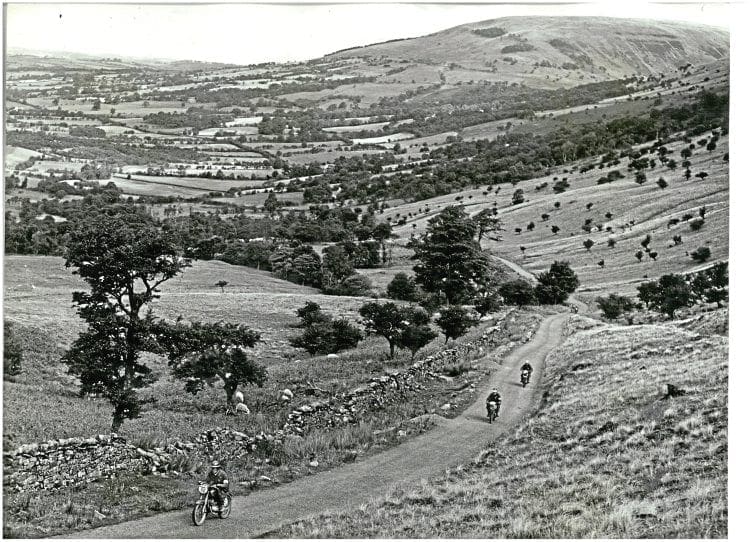
The 1954 ISDT in Wales. Does anyone have specific route details?
Does any reader have details of the routes taken, or even better, an original 1954 route card that we could copy?
We would of course be happy to pay copying and postal costs.
Thanks for any help.
John Robinson, via email (john726robinson@btinternet.com)
Read more Letters, Opinion, News and Features in the December 2019 issue of TCM –on sale now!
A friend and I would like to ride our BSAs around some parts of the 1954 ISDT that was based in Llandrindod Wells as part of our ‘bucket list’ of things we want to do.
Unfortunately, we don’t have any proper route details to follow.
There are details on internet sites but they aren’t really clear enough for us to work out the route.

The 1954 ISDT in Wales. Does anyone have specific route details?
Does any reader have details of the routes taken, or even better, an original 1954 route card that we could copy?
We would of course be happy to pay copying and postal costs.
Thanks for any help.
John Robinson, via email (john726robinson@btinternet.com)
Read more Letters, Opinion, News and Features in the December 2019 issue of TCM –on sale now!
- Local time
- Today, 09:50
- Joined
- Jan 5, 2006
- Messages
- 54,198
- Points
- 1,327
- First Name
- Dave
- My Ride
- Speedmaster
- Riding Since
- 1974
Mortons Archive: Military motorcycles in World War II
We’ve delved into the illustrious Mortons Archive to give you a glimpse into the use of Triumph and Norton motorcycles in the Second World War.
Triumph suffers with Coventry

The despatch riders of the women’s Royal Naval Service taken in 1941. Photo: Mortons Archive

July 1940; men from the second BEF, back after the evacuation from France. Photo: Mortons Archive.
At the outbreak of the Second World War, Triumph was riding a wave, with their single cylinder Tigers among the best and most attractive.
Between 1938 and 1941, around 10,000 side-valve 3SWs were supplied to the British military, replacing the 3S. In 1940, the Coventry-based factory supplied around 1,500 5SWs – but production was to end suddenly on the night of November 14, when Germany’s bombs reigned down in the single most concentrated attack on a British city in the war. The bombing claimed hundreds of lives, destroyed over 4,300 homes and damaged two-thirds of the city’s buildings, including the Triumph factory. As a result, a number of 3SWs, the first 50 of the 3TW model – a 350cc twin which Triumph had planned to produce in large numbers – plus tooling, plans and spares were destroyed.
Triumph moved its operation into an old foundry building in Warwick, from where it produced the 3HW model, which was based on the Tiger 80. Triumph eventually found a permanent new home at Meriden.
Norton’s 16H and Big 4
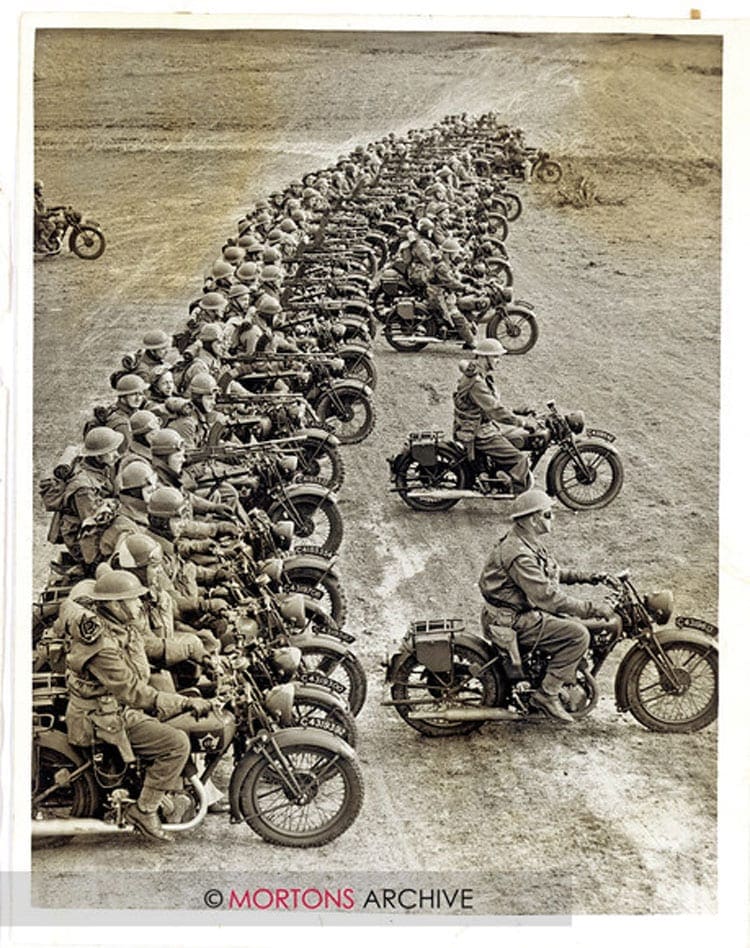
Long line of 16Hs and Big 4s in April 1941. Photo: Mortons Archive.

Taking aim, using one of the two-wheel drive Big 4s as cover. Photo: Mortons Archive.
For a firm that was making 4000 machines in 1935, Norton was able to claim the supply of 100,000 motorcycles to the forces after the Second World War.
The models were the 16H and Big 4, which went to army, navy and air forces around the world. The 16H model chosen was the pre-1937 type. If, however, a post-1938 model had been chosen by the powers that be, they would have had the totally enclosed and fully lubricated valve gear.
The 16H model was supplied for 10 years in total. During the first two years of the war, it was the most popular military motorcycle. The Matchless G3L was to push the 16H back, although some continued on the front line.
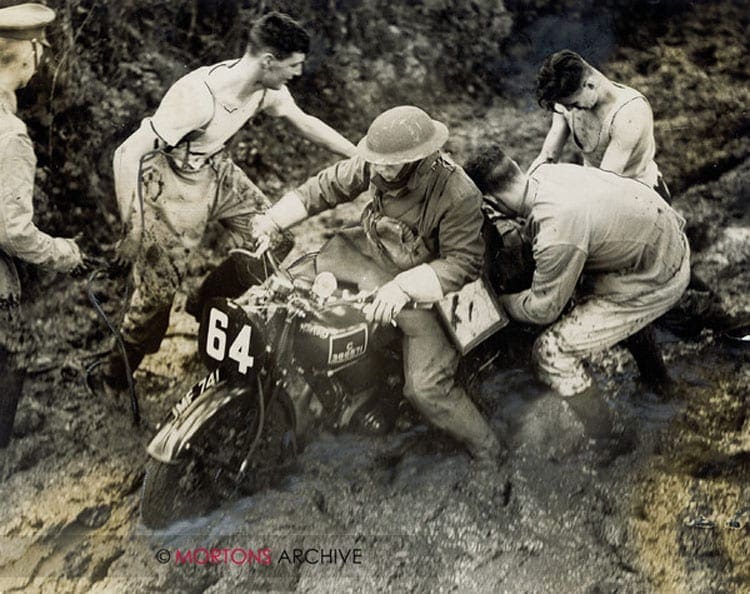
Fusilier W Santer needs a little help from his friends; the 16H wasn’t possessed of great ground clearance. Photo: Mortons Archive
Norton also supplied the Military Model 1, or Big 4 as it was to become more commonly known. With a 633cc sv engine, the machine featured drive to both the rear wheel and sidecar wheel. With the wheels locked, the outfit would only move in a straight line. The arrival of the all-round and capable American Jeep sealed the Big 4’s fate, and many wound up in the western desert towing bomb trains in Australia.
Though not as glamorous, the 16Hs were supplied in 1945 and continued well into the 1950s, with Norton becoming the second largest supplier of motorcycles to the British Army.
The images used in this article are available in high-resolution for commercial and personal use. If you’re interested in purchasing these images, or want to find out more about Mortons Archive, visit www.mortonsarchive.com
We’ve delved into the illustrious Mortons Archive to give you a glimpse into the use of Triumph and Norton motorcycles in the Second World War.
Triumph suffers with Coventry

The despatch riders of the women’s Royal Naval Service taken in 1941. Photo: Mortons Archive

July 1940; men from the second BEF, back after the evacuation from France. Photo: Mortons Archive.
At the outbreak of the Second World War, Triumph was riding a wave, with their single cylinder Tigers among the best and most attractive.
Between 1938 and 1941, around 10,000 side-valve 3SWs were supplied to the British military, replacing the 3S. In 1940, the Coventry-based factory supplied around 1,500 5SWs – but production was to end suddenly on the night of November 14, when Germany’s bombs reigned down in the single most concentrated attack on a British city in the war. The bombing claimed hundreds of lives, destroyed over 4,300 homes and damaged two-thirds of the city’s buildings, including the Triumph factory. As a result, a number of 3SWs, the first 50 of the 3TW model – a 350cc twin which Triumph had planned to produce in large numbers – plus tooling, plans and spares were destroyed.
Triumph moved its operation into an old foundry building in Warwick, from where it produced the 3HW model, which was based on the Tiger 80. Triumph eventually found a permanent new home at Meriden.
Norton’s 16H and Big 4

Long line of 16Hs and Big 4s in April 1941. Photo: Mortons Archive.

Taking aim, using one of the two-wheel drive Big 4s as cover. Photo: Mortons Archive.
For a firm that was making 4000 machines in 1935, Norton was able to claim the supply of 100,000 motorcycles to the forces after the Second World War.
The models were the 16H and Big 4, which went to army, navy and air forces around the world. The 16H model chosen was the pre-1937 type. If, however, a post-1938 model had been chosen by the powers that be, they would have had the totally enclosed and fully lubricated valve gear.
The 16H model was supplied for 10 years in total. During the first two years of the war, it was the most popular military motorcycle. The Matchless G3L was to push the 16H back, although some continued on the front line.

Fusilier W Santer needs a little help from his friends; the 16H wasn’t possessed of great ground clearance. Photo: Mortons Archive
Norton also supplied the Military Model 1, or Big 4 as it was to become more commonly known. With a 633cc sv engine, the machine featured drive to both the rear wheel and sidecar wheel. With the wheels locked, the outfit would only move in a straight line. The arrival of the all-round and capable American Jeep sealed the Big 4’s fate, and many wound up in the western desert towing bomb trains in Australia.
Though not as glamorous, the 16Hs were supplied in 1945 and continued well into the 1950s, with Norton becoming the second largest supplier of motorcycles to the British Army.
The images used in this article are available in high-resolution for commercial and personal use. If you’re interested in purchasing these images, or want to find out more about Mortons Archive, visit www.mortonsarchive.com
- Local time
- Today, 09:50
- Joined
- Jan 5, 2006
- Messages
- 54,198
- Points
- 1,327
- First Name
- Dave
- My Ride
- Speedmaster
- Riding Since
- 1974
Brown bikes a hit at Bonhams sale
The motorcycle sale hosted at the Barber Motorsports Museum, by Bonhams, on October 5, featured two motorcycles owned by On Any Sunday director Bruce Brown, plus a truly impressive collection of Vincent motorcycles.

Formerly owned by Brown were a 1967 Triumph T20 Mountain Cub (pictured above) and a 1970 Husqvarna 250 Cross, the Cub realising £6109 and the Husky £39 over £15k.
Read more in the December 2019 issue of TCM – on sale now!
The motorcycle sale hosted at the Barber Motorsports Museum, by Bonhams, on October 5, featured two motorcycles owned by On Any Sunday director Bruce Brown, plus a truly impressive collection of Vincent motorcycles.

Formerly owned by Brown were a 1967 Triumph T20 Mountain Cub (pictured above) and a 1970 Husqvarna 250 Cross, the Cub realising £6109 and the Husky £39 over £15k.
Read more in the December 2019 issue of TCM – on sale now!
- Local time
- Today, 04:50
- Joined
- Jan 28, 2006
- Messages
- 21,153
- Points
- 952
- Age
- 86
- Location
- Halifax
- First Name
- Rocky
- My Ride
- 2006 T100 Bonneville
- Riding Since
- 1992
Although I already knew most of that part of the war history, I enjoyed the WWII article 



- Local time
- Today, 09:50
- Joined
- Jan 5, 2006
- Messages
- 54,198
- Points
- 1,327
- First Name
- Dave
- My Ride
- Speedmaster
- Riding Since
- 1974
Meddling about
I enjoyed the ‘Men who mattered’ piece in the November 2019 issue, regarding H G Tyrell Smith.

ABOVE: The 1930 programme, featuring Tyrrell (sic) Smith, and the medal (below), with the same spelling mistake repeated!
One small fact missing from the article was that Tyrell competed in the first 1930 Pioneer Run (copy of programme attached) as rider number 37, competing on a 1912 499cc Rudge; appropriate given that he was a Rudge factory rider at that point in time and one of a team of Rudge riders in that event, including Graham Walker and Ernie Nott.
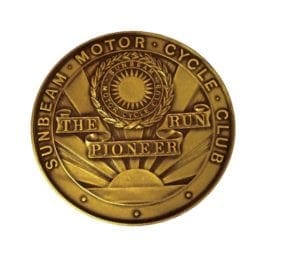
Read more of this Letters and other Letters, Opinion, News and Features in the December 2019 issue of TCM –on sale now!
I enjoyed the ‘Men who mattered’ piece in the November 2019 issue, regarding H G Tyrell Smith.

ABOVE: The 1930 programme, featuring Tyrrell (sic) Smith, and the medal (below), with the same spelling mistake repeated!
One small fact missing from the article was that Tyrell competed in the first 1930 Pioneer Run (copy of programme attached) as rider number 37, competing on a 1912 499cc Rudge; appropriate given that he was a Rudge factory rider at that point in time and one of a team of Rudge riders in that event, including Graham Walker and Ernie Nott.

Read more of this Letters and other Letters, Opinion, News and Features in the December 2019 issue of TCM –on sale now!
- Local time
- Today, 09:50
- Joined
- Jan 5, 2006
- Messages
- 54,198
- Points
- 1,327
- First Name
- Dave
- My Ride
- Speedmaster
- Riding Since
- 1974
From the archive: Benelli Tours: Touring in style?
Fancy riding an Italian classic in some spectacular scenery? Then this might just be the trip for you.
The small town of Tavullia is 10 miles inland from Pesaro on the Adriatic coast. In 1911, the widowed Teresa Benelli bought a workshop in Pesaro, to ensure a future for her six sons – Giuseppe, Giovanni, Filippo, Francesco, Domenico and Antonio ‘Tonino’, though the family actually came from Tavullia to the larger town.
Nowadays, the community of just over 7000 people is best known as MotoGP legend Valentino Rossi’s home town and that is where his house and training track is… as well as his restaurant, with the fan club offices next door.
A large poster adorns the bridge in the centre of the town and every lamppost is wrapped with yellow ribbons with Rossi’s number 46 on them, leaving you in no doubt you’re on ‘The Doctor’s’ turf.

Lovely roads are a given. Great food, too.
Around 25 years ago in Milan, north of Pesaro, Mototouring was founded by the multi-lingual Eligio Arturi. In the two and a half decades since, the firm has successfully run tours in Europe, Africa, Central and South America and carved out an enviable reputation.
Until recently, Mototouring focused on modern motorcycles – the rental of machines and riding gear, providing shipping and storage – and that’s just some of the services on offer.
Eligio, though, has always had a passion for classics and has teamed up with Moto Club Pesaro T Benelli, the Registro Storico Benelli and the Officine Benelli – or in other words the official Benelli Museum, housing 150 fully restored motorcycles – in a new enterprise.

The clubroom at the Benelli Museum.
Run by Paulo Marchinelli, the Moto Club Pesaro was formed by enthusiasts whose primary interest was the preservation of Benelli motorcycles and some of the other now extinct brands from Pesaro and the surrounding region.
The group bought one of the buildings from the original Benelli factory and set about restoring it to form a museum and clubhouse.
The building is actually post-Second World War, as the originals were destroyed by Allied bombs.
With a lot of the work now done (but still more to do) the building houses a comfortable office stacked with journals to enable machine identification; it is now one of the accepted bodies to date motorcycles in Italy.

There’s plenty of literature in the reading room.
In addition there is an area of the club (Valentino is a club member) for members to watch MotoGP on a large screen, surrounded by engines and trophies in glass cabinets.
In the centre is the large museum area where the members have created a superb display showing the history of Benelli, while another equally large area houses motorcycles awaiting restoration and available for use.
In the museum section can be found examples of the early models from the 1920s such as the 1925 Moto Leggara 125cc Tipo Sport, the 175cc Corsa and other small capacity models, moving through to the late 1930s when you start to see 250cc and 500cc models appearing.
It should be noted the first Benellis were not produced until 1921; in the beginning the Pesaro workshop was only a service garage.

Mannequins are used extensively in the Benelli museum. Motorcycle is a 1927 175cc Benelli Corsa.
Despite this late start, Tonino Benelli started to race successfully and after his brother Giuseppe designed the 175cc four-stroke engined machine, complete with an overhead camshaft, Tonino became Italian champion in 1927, 1928, 1930 and 1931.
Racing was to play a big part in Benelli’s reputation, with larger bikes coming in the 1930s and in 1940 Benelli launched a 250cc four-cylinder racer with double overhead camshaft and supercharger that would never see the track due to the war.
During the conflict the company Benelli produced only military motorcycles.
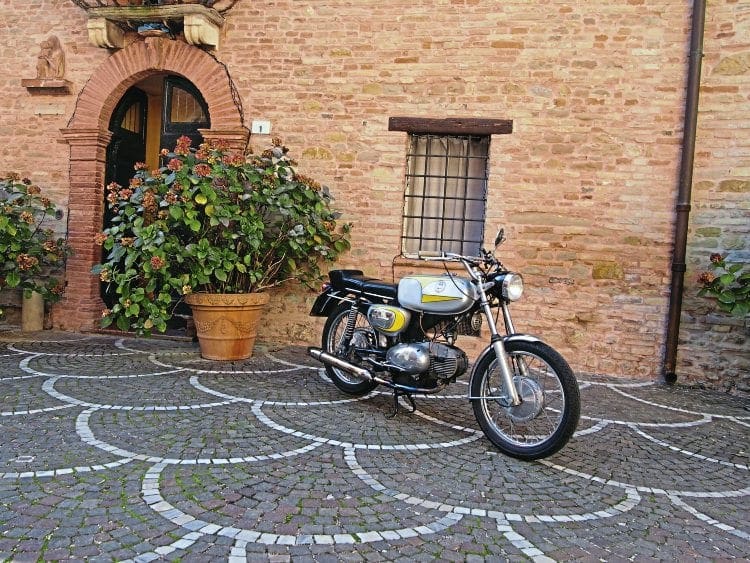
Ian Kerr’s 250cc mount, from the Motobi era.
After the war, with Dario Ambrosini in the saddle, they won the 1950 250cc world championship.
But Ambrosini’s death in 1951 saw a heart-broken Benelli withdraw from GP racing for several years.
But one brother, Giuseppe Benelli, then left and set up Motobi, with the classic two- and four-stroke egg-shaped engine, of small and medium displacement.
Benelli still managed to win the first Motogiro d’Italia in 1953 with the racer Tartarini.
At the start of the 1960s the Motobi and Benelli brands merged to form one company and once again achieved racing success with Tarquinio Provini and Renzo Pasolini, taking a second 250cc world title in 1969 with Australian Kel Carruthers.
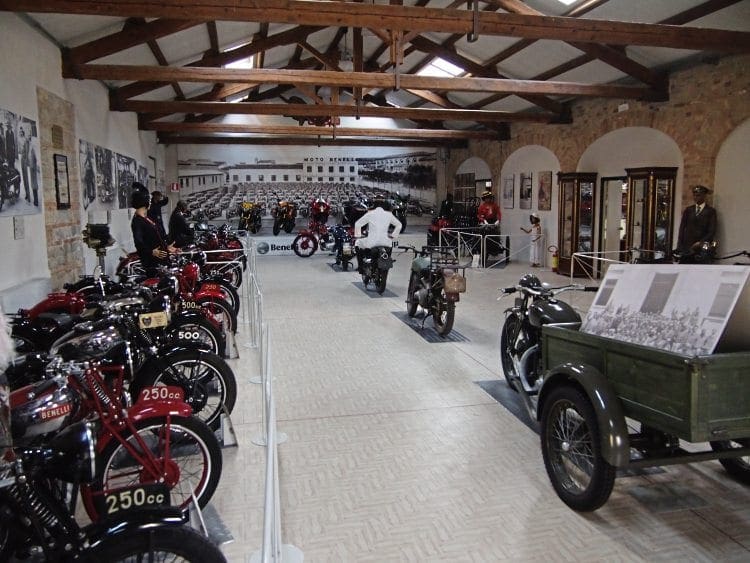
Line-up of some fabulous Benelli machinery.
Benelli then went through a series of different owners and in December 2005 became part of the Qianjiang Corporation located in Wenling, China.
Modern four cylinder machines bearing the historic brand name also sit in the museum and are in use by many members of the club as their everyday mounts.
The club is not only interested in providing a static museum, but is even keener on taking it outside to a wider audience by taking part in numerous classic events.
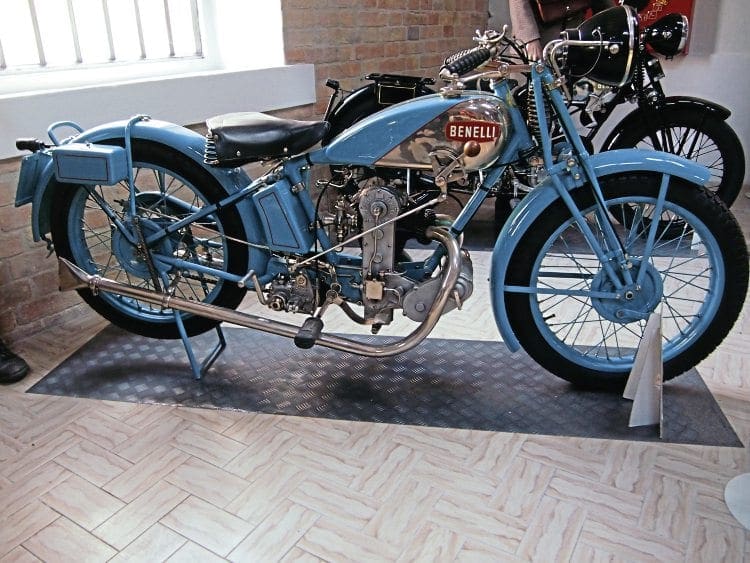
Not all Benellis are red. Here’s a lovely 175cc cammy from the 1930s.
As part of this ideal, members see the continued use of the machines as paramount to helping convert other enthusiasts in order to preserve not only their chosen marque, but classic motorcycles in general.
The desire to use the machines and a chance meeting with Eligio led to an idea to run a tour using members’ bikes and those from the museum, taking in some of the best roads in the area.
As well as riding, the idea was to trace some of Italy’s motorcycle history and turn it into a classic festival and journey of discovery.
When you throw in Italian food, history, architecture and some decent weather, it becomes an irresistible temptation… so I joined a group of knowledgeable American collectors and enthusiasts for the inaugural Benelli Vintage Tour. Here’s my diary of events…
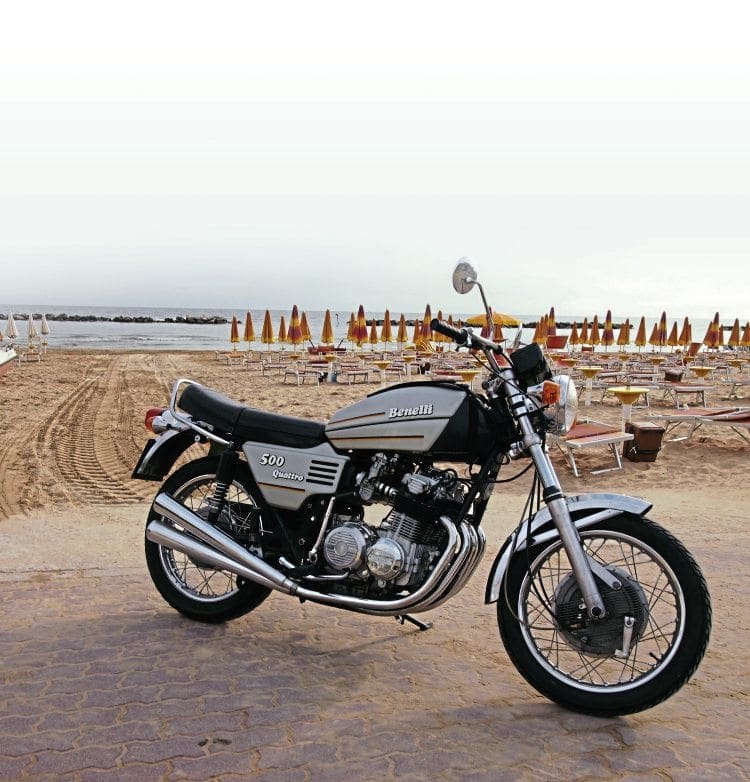
The 500cc Benelli four, from the De Tomaso era.
Thursday
A short train ride from the airport at Bologna saw us arrive at Pesaro and our hotel base on the seafront for the week.
Friday
We paraded at the club house/museum to be allocated our machines for the week, although it was stressed that we could swap around in order to get a flavour and the diversity of the Benelli brand.
While the museum traces the firm’s 100-year history with machines from all decades, the bikes we were allocated were the more practical 1970s models, from when the firm was taken over and modernised.
In 1972, the company was bought by the Argentinean entrepreneur Alejandro De Tomaso, who also acquired Moto Guzzi .
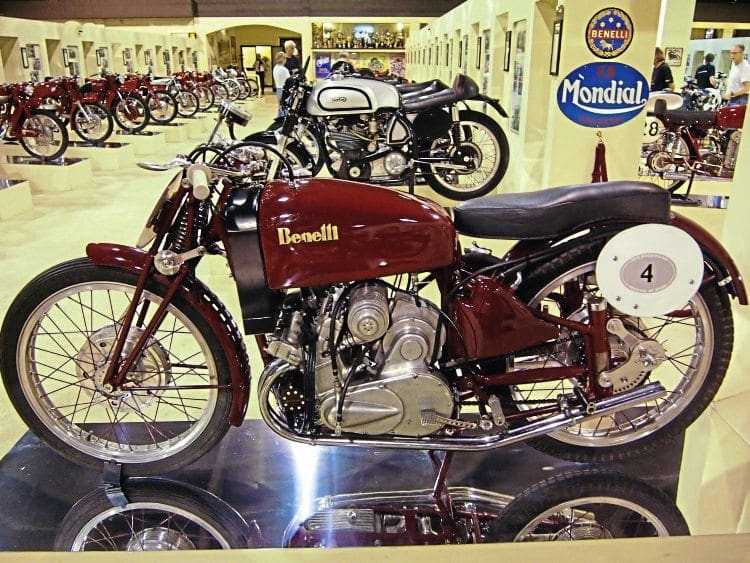
The 1939 supercharged Benelli four – the museum has an engine but the whole machine is in Morbidelli’s collection.
He relaunched and enlarged the product range, presenting multi-cylinder motorcycles and a prestigious 750cc Sei, which was the first six-cylinder motorcycle produced available for purchase by the general public.
Despite my attempts to get out on one of the original overhead camshaft bikes from the 1920s or 30s, it was not to be, and I had to ‘settle’ for a 250cc single from the Motobi era when the 650cc Tornado that I was originally allocated wouldn’t start.
My riding companions seemed more than happy to get sixes and fours with electric starters, as well as some of the two-strokes from the 1970s.
Now, while daily itineraries had been mapped out, it became clear – in true Italian style – that such timings were just a guide and each day would depend on weather and the availability of some of the owners of the private collections we were due to see.
To make our life easier, we wouldn’t need to worry about navigation, as in addition to a back-up van, club members would ride with us.

Vast array of machines in the Morbidelli emporium, featuring machines from through the ages.
However, when the local traffic cops turned up, we realised we were getting a proper escort out of town on blue lights and two-tones, such is the pull the club has locally.
Once out of Pesaro, club riders kept everything flowing by holding traffic at roundabouts and junctions and nobody seemed to worry it was just an orange-jacketed rider and not a police officer – only in Italy!
Saturday
This was a short day in riding terms, as most of us spent quite lot of time examining the exhibits in the museum which the organisers had anticipated, so it was a route that allowed us to get used to the machines and each other’s riding styles.
Still, as well as some fabulous roads we managed to visit a historic town complete with stunning church, plus a fascinating exhibit of mummified human remains in a different church.
It was clear that club members on the escort machines were not afraid to use their classics to the full in terms of performance and handling.

Former 50cc world champion Eugenio Lazzarini has quite a collection.
‘Super Mario’ showed that a 900 Sei would not break its crankshaft (a popular belief if they are revved too much) if the performance was used and, despite dragging its undercarriage, would hold its line through any bend… the rider smiling all the time as he did so!
Sunday
Today, I was out on the 650cc Tornado, it having been repaired.
We headed to Loreto for lunch and a look around the large cathedral, before heading back down the coast road. Meanwhile, others were also swapping machines and all seemed to have different gear change patterns as well as right and left-foot systems… just to keep everyone on their toes.
Monday
A ride north towards Rimini and an appointment for a guided tour around the Bimota factory.
Founded in 1973 and having endured a chequered history, but now with all its problems seemingly behind it, Bimota continues to produce some pretty special machines; despite the brevity of the tour, one of our group was impressed enough to place an order.
Lunch was then taken in the Republic of San Mario before another breathtaking ride through the hills back to the hotel.
Tuesday
Tuesday was a convoluted ride through the hills and a few historic towns, before we ended up at Tavullia for a look from the hillside at Rossi’s practise track… and then headed into town for lunch at his restaurant.

Giancarlo Morbidelli with his 500cc grand prix racer.
Staying on the theme of MotoGP, we then headed to Coriano for a look around the Marco Simoncelli museum.
With stunning weather and roads putting everyone in the mood for racing, we headed back to Pesaro and a look round the Morbidelli Museum.
No matter how many times I visit this museum I never get bored as it is one of the best in the world, boasting 350 road and racing motorcycles.
Machines from all over the world, not just Italy, are displayed in a series of well-lit halls.
Bikes range from those immaculately restored right down to those with original paintwork, just as they were discovered.
Road and race bikes are interspersed and each is on a mirrored plinth.
Exotica sits in among the mundane, and by following the ‘prescribed route’ based on time decades, you can trace the history of motorcycling the world over from the turn of the last century right through to the 1990s.
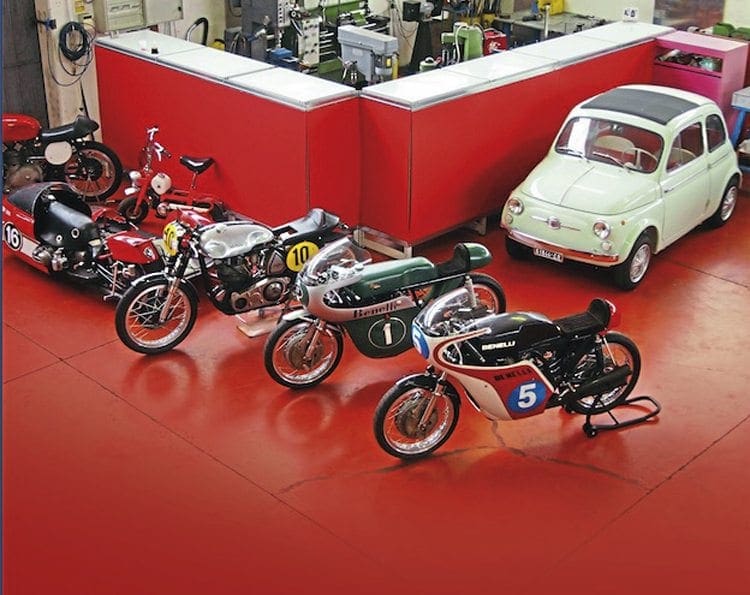
They look like toys… which makes this perhaps the world’s best toy cupboard…
In 1998 Morbidelli made a 847cc V8, shaft drive road-going motorcycle. Sold direct at a premium price and delivered in its own packing case, at that time it was the world’s most expensive motorcycle… although few sold and one of the last sits in the foyer.
Wednesday
This was to be one of the longer days riding up into the hills.
Unfortunately the weather turned and most mountains were cloaked in clouds with little in the way of views, and we got somewhat wet on our ride back.
Thursday
Given the poorer weather, a coach was quickly arranged to take us to the Fasassi underground grotto system which was stunning and one of the best examples of the wonder of nature.
It was a good job we were in a bus, as when we arrived at the TM factory back in Pesaro we would have been drowned rats dripping around a very hi-tech factory.
TM was launched in 1976 by two childhood friends Claudio Flenghi and Francesco Battistelli (‘Mr Engine’ and ‘Mr Frame’) and the firm has gone onto build bikes that are designed, engineered and hand-built in-house.
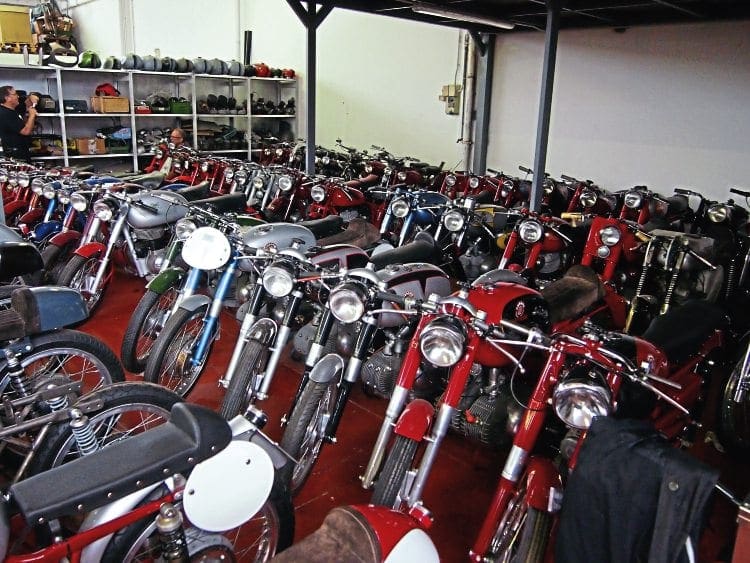
More than 200 motorcycles in a private collection.
Having looked around some very modern machines, it was back to classics and a short hop down the road to see former 50cc world champion Eugenio Lazzarini and his collection of racing machines.
Lazzarini’s career, which spanned 15 seasons, started in 1969 and the diminutive Italian won the 1978 championship on an MBA (Morbidelli) and then took the 50cc championship for the next two years on a Kriedler.
Among his bikes are several he built himself, and he provided an interesting talk on his life and times.
Friday
Another damp day, but that did not stop us riding out to view a private collection of more than 200 machines, including Kel Caruthers’ 1969 250cc title-winning Benelli four, which was started up for our benefit.
Other notable machines included an Eddie Lawson championship-winning Yamaha. On the roadster front there are many examples of various small Italian factories that did not last long, but still contributed to Italian motorcycle history.
A stop at the magnificent Rossini opera house concluded the day before we dropped off the motorcycles at the museum before cleaning up for the farewell meal at the clubhouse.
Saturday
For me it was back on the train and plane, but all the others had elected to stay on for the MotoGP race to finish off their time in Europe before flying home.
Fancy riding an Italian classic in some spectacular scenery? Then this might just be the trip for you.
The small town of Tavullia is 10 miles inland from Pesaro on the Adriatic coast. In 1911, the widowed Teresa Benelli bought a workshop in Pesaro, to ensure a future for her six sons – Giuseppe, Giovanni, Filippo, Francesco, Domenico and Antonio ‘Tonino’, though the family actually came from Tavullia to the larger town.
Nowadays, the community of just over 7000 people is best known as MotoGP legend Valentino Rossi’s home town and that is where his house and training track is… as well as his restaurant, with the fan club offices next door.
A large poster adorns the bridge in the centre of the town and every lamppost is wrapped with yellow ribbons with Rossi’s number 46 on them, leaving you in no doubt you’re on ‘The Doctor’s’ turf.

Lovely roads are a given. Great food, too.
Around 25 years ago in Milan, north of Pesaro, Mototouring was founded by the multi-lingual Eligio Arturi. In the two and a half decades since, the firm has successfully run tours in Europe, Africa, Central and South America and carved out an enviable reputation.
Until recently, Mototouring focused on modern motorcycles – the rental of machines and riding gear, providing shipping and storage – and that’s just some of the services on offer.
Eligio, though, has always had a passion for classics and has teamed up with Moto Club Pesaro T Benelli, the Registro Storico Benelli and the Officine Benelli – or in other words the official Benelli Museum, housing 150 fully restored motorcycles – in a new enterprise.

The clubroom at the Benelli Museum.
Run by Paulo Marchinelli, the Moto Club Pesaro was formed by enthusiasts whose primary interest was the preservation of Benelli motorcycles and some of the other now extinct brands from Pesaro and the surrounding region.
The group bought one of the buildings from the original Benelli factory and set about restoring it to form a museum and clubhouse.
The building is actually post-Second World War, as the originals were destroyed by Allied bombs.
With a lot of the work now done (but still more to do) the building houses a comfortable office stacked with journals to enable machine identification; it is now one of the accepted bodies to date motorcycles in Italy.

There’s plenty of literature in the reading room.
In addition there is an area of the club (Valentino is a club member) for members to watch MotoGP on a large screen, surrounded by engines and trophies in glass cabinets.
In the centre is the large museum area where the members have created a superb display showing the history of Benelli, while another equally large area houses motorcycles awaiting restoration and available for use.
In the museum section can be found examples of the early models from the 1920s such as the 1925 Moto Leggara 125cc Tipo Sport, the 175cc Corsa and other small capacity models, moving through to the late 1930s when you start to see 250cc and 500cc models appearing.
It should be noted the first Benellis were not produced until 1921; in the beginning the Pesaro workshop was only a service garage.

Mannequins are used extensively in the Benelli museum. Motorcycle is a 1927 175cc Benelli Corsa.
Despite this late start, Tonino Benelli started to race successfully and after his brother Giuseppe designed the 175cc four-stroke engined machine, complete with an overhead camshaft, Tonino became Italian champion in 1927, 1928, 1930 and 1931.
Racing was to play a big part in Benelli’s reputation, with larger bikes coming in the 1930s and in 1940 Benelli launched a 250cc four-cylinder racer with double overhead camshaft and supercharger that would never see the track due to the war.
During the conflict the company Benelli produced only military motorcycles.

Ian Kerr’s 250cc mount, from the Motobi era.
After the war, with Dario Ambrosini in the saddle, they won the 1950 250cc world championship.
But Ambrosini’s death in 1951 saw a heart-broken Benelli withdraw from GP racing for several years.
But one brother, Giuseppe Benelli, then left and set up Motobi, with the classic two- and four-stroke egg-shaped engine, of small and medium displacement.
Benelli still managed to win the first Motogiro d’Italia in 1953 with the racer Tartarini.
At the start of the 1960s the Motobi and Benelli brands merged to form one company and once again achieved racing success with Tarquinio Provini and Renzo Pasolini, taking a second 250cc world title in 1969 with Australian Kel Carruthers.

Line-up of some fabulous Benelli machinery.
Benelli then went through a series of different owners and in December 2005 became part of the Qianjiang Corporation located in Wenling, China.
Modern four cylinder machines bearing the historic brand name also sit in the museum and are in use by many members of the club as their everyday mounts.
The club is not only interested in providing a static museum, but is even keener on taking it outside to a wider audience by taking part in numerous classic events.

Not all Benellis are red. Here’s a lovely 175cc cammy from the 1930s.
As part of this ideal, members see the continued use of the machines as paramount to helping convert other enthusiasts in order to preserve not only their chosen marque, but classic motorcycles in general.
The desire to use the machines and a chance meeting with Eligio led to an idea to run a tour using members’ bikes and those from the museum, taking in some of the best roads in the area.
As well as riding, the idea was to trace some of Italy’s motorcycle history and turn it into a classic festival and journey of discovery.
When you throw in Italian food, history, architecture and some decent weather, it becomes an irresistible temptation… so I joined a group of knowledgeable American collectors and enthusiasts for the inaugural Benelli Vintage Tour. Here’s my diary of events…

The 500cc Benelli four, from the De Tomaso era.
Thursday
A short train ride from the airport at Bologna saw us arrive at Pesaro and our hotel base on the seafront for the week.
Friday
We paraded at the club house/museum to be allocated our machines for the week, although it was stressed that we could swap around in order to get a flavour and the diversity of the Benelli brand.
While the museum traces the firm’s 100-year history with machines from all decades, the bikes we were allocated were the more practical 1970s models, from when the firm was taken over and modernised.
In 1972, the company was bought by the Argentinean entrepreneur Alejandro De Tomaso, who also acquired Moto Guzzi .

The 1939 supercharged Benelli four – the museum has an engine but the whole machine is in Morbidelli’s collection.
He relaunched and enlarged the product range, presenting multi-cylinder motorcycles and a prestigious 750cc Sei, which was the first six-cylinder motorcycle produced available for purchase by the general public.
Despite my attempts to get out on one of the original overhead camshaft bikes from the 1920s or 30s, it was not to be, and I had to ‘settle’ for a 250cc single from the Motobi era when the 650cc Tornado that I was originally allocated wouldn’t start.
My riding companions seemed more than happy to get sixes and fours with electric starters, as well as some of the two-strokes from the 1970s.
Now, while daily itineraries had been mapped out, it became clear – in true Italian style – that such timings were just a guide and each day would depend on weather and the availability of some of the owners of the private collections we were due to see.
To make our life easier, we wouldn’t need to worry about navigation, as in addition to a back-up van, club members would ride with us.

Vast array of machines in the Morbidelli emporium, featuring machines from through the ages.
However, when the local traffic cops turned up, we realised we were getting a proper escort out of town on blue lights and two-tones, such is the pull the club has locally.
Once out of Pesaro, club riders kept everything flowing by holding traffic at roundabouts and junctions and nobody seemed to worry it was just an orange-jacketed rider and not a police officer – only in Italy!
Saturday
This was a short day in riding terms, as most of us spent quite lot of time examining the exhibits in the museum which the organisers had anticipated, so it was a route that allowed us to get used to the machines and each other’s riding styles.
Still, as well as some fabulous roads we managed to visit a historic town complete with stunning church, plus a fascinating exhibit of mummified human remains in a different church.
It was clear that club members on the escort machines were not afraid to use their classics to the full in terms of performance and handling.

Former 50cc world champion Eugenio Lazzarini has quite a collection.
‘Super Mario’ showed that a 900 Sei would not break its crankshaft (a popular belief if they are revved too much) if the performance was used and, despite dragging its undercarriage, would hold its line through any bend… the rider smiling all the time as he did so!
Sunday
Today, I was out on the 650cc Tornado, it having been repaired.
We headed to Loreto for lunch and a look around the large cathedral, before heading back down the coast road. Meanwhile, others were also swapping machines and all seemed to have different gear change patterns as well as right and left-foot systems… just to keep everyone on their toes.
Monday
A ride north towards Rimini and an appointment for a guided tour around the Bimota factory.
Founded in 1973 and having endured a chequered history, but now with all its problems seemingly behind it, Bimota continues to produce some pretty special machines; despite the brevity of the tour, one of our group was impressed enough to place an order.
Lunch was then taken in the Republic of San Mario before another breathtaking ride through the hills back to the hotel.
Tuesday
Tuesday was a convoluted ride through the hills and a few historic towns, before we ended up at Tavullia for a look from the hillside at Rossi’s practise track… and then headed into town for lunch at his restaurant.

Giancarlo Morbidelli with his 500cc grand prix racer.
Staying on the theme of MotoGP, we then headed to Coriano for a look around the Marco Simoncelli museum.
With stunning weather and roads putting everyone in the mood for racing, we headed back to Pesaro and a look round the Morbidelli Museum.
No matter how many times I visit this museum I never get bored as it is one of the best in the world, boasting 350 road and racing motorcycles.
Machines from all over the world, not just Italy, are displayed in a series of well-lit halls.
Bikes range from those immaculately restored right down to those with original paintwork, just as they were discovered.
Road and race bikes are interspersed and each is on a mirrored plinth.
Exotica sits in among the mundane, and by following the ‘prescribed route’ based on time decades, you can trace the history of motorcycling the world over from the turn of the last century right through to the 1990s.

They look like toys… which makes this perhaps the world’s best toy cupboard…
In 1998 Morbidelli made a 847cc V8, shaft drive road-going motorcycle. Sold direct at a premium price and delivered in its own packing case, at that time it was the world’s most expensive motorcycle… although few sold and one of the last sits in the foyer.
Wednesday
This was to be one of the longer days riding up into the hills.
Unfortunately the weather turned and most mountains were cloaked in clouds with little in the way of views, and we got somewhat wet on our ride back.
Thursday
Given the poorer weather, a coach was quickly arranged to take us to the Fasassi underground grotto system which was stunning and one of the best examples of the wonder of nature.
It was a good job we were in a bus, as when we arrived at the TM factory back in Pesaro we would have been drowned rats dripping around a very hi-tech factory.
TM was launched in 1976 by two childhood friends Claudio Flenghi and Francesco Battistelli (‘Mr Engine’ and ‘Mr Frame’) and the firm has gone onto build bikes that are designed, engineered and hand-built in-house.

More than 200 motorcycles in a private collection.
Having looked around some very modern machines, it was back to classics and a short hop down the road to see former 50cc world champion Eugenio Lazzarini and his collection of racing machines.
Lazzarini’s career, which spanned 15 seasons, started in 1969 and the diminutive Italian won the 1978 championship on an MBA (Morbidelli) and then took the 50cc championship for the next two years on a Kriedler.
Among his bikes are several he built himself, and he provided an interesting talk on his life and times.
Friday
Another damp day, but that did not stop us riding out to view a private collection of more than 200 machines, including Kel Caruthers’ 1969 250cc title-winning Benelli four, which was started up for our benefit.
Other notable machines included an Eddie Lawson championship-winning Yamaha. On the roadster front there are many examples of various small Italian factories that did not last long, but still contributed to Italian motorcycle history.
A stop at the magnificent Rossini opera house concluded the day before we dropped off the motorcycles at the museum before cleaning up for the farewell meal at the clubhouse.
Saturday
For me it was back on the train and plane, but all the others had elected to stay on for the MotoGP race to finish off their time in Europe before flying home.
- Local time
- Today, 00:50
- Joined
- May 4, 2016
- Messages
- 3,953
- Points
- 472
- Age
- 67
- Location
- Northern California
- First Name
- Stephen
- My Ride
- 1995 Triumph Thunderbird 900, "Maureen O'Hara"
- Riding Since
- 2017
Wow! What a great collection.
- Local time
- Today, 03:50
- Joined
- Jan 5, 2006
- Messages
- 29,608
- Points
- 1,218
- Age
- 79
- Location
- Dania Beach, Florida
- First Name
- Carl
- My Ride
- 2020 Bonneville T120 Black
- Riding Since
- 1958
Awesome! I would love to visit the museum and ride in that area. 

 |
Support TriumphTalk by becoming a Premium Member. |
What You Get |
